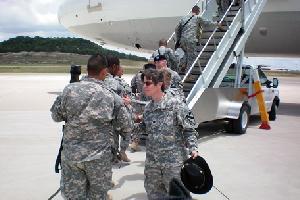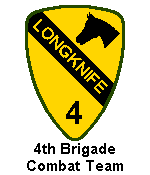
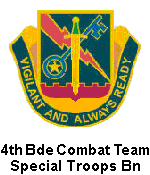
Special Troops Basttalion
4th Brigade Combat Team
Historical Missions
"Vigilant And Always Ready"


 Army Modular Force, 2005
Army Modular Force, 2005


 On 24 May 2005, following six months of extensive planning, officers of the
1st Cavalry Division began executing the monumental task of reorganizing and
realigning its manpower and equipment resources into the Army Matrix of
Modular Forces. As each Brigade changed command, they changed their colors and
become a Brigade Unit of Action (BUA). Under the reorganization, the Division
will have six Brigades.
On 24 May 2005, following six months of extensive planning, officers of the
1st Cavalry Division began executing the monumental task of reorganizing and
realigning its manpower and equipment resources into the Army Matrix of
Modular Forces. As each Brigade changed command, they changed their colors and
become a Brigade Unit of Action (BUA). Under the reorganization, the Division
will have six Brigades.
 While undertaking the transformation changes, the Division experienced nearly
a fifty percent turnover in personnel while performing the coordination of
arrival and reallocation of critical new equipment required to support their
new missions. Simultaneously, with the equipment changeovers, new training
and maintenance programs that were initiated to prepare for possible combat
redeployment as early as 15 April, 2006 or as may be directed by the Army
Command. The completion the Division transformation will occur with the major
milestone of "Standing Up" the 4th Brigade Combat Team at Ft. Bliss, Texas.
While undertaking the transformation changes, the Division experienced nearly
a fifty percent turnover in personnel while performing the coordination of
arrival and reallocation of critical new equipment required to support their
new missions. Simultaneously, with the equipment changeovers, new training
and maintenance programs that were initiated to prepare for possible combat
redeployment as early as 15 April, 2006 or as may be directed by the Army
Command. The completion the Division transformation will occur with the major
milestone of "Standing Up" the 4th Brigade Combat Team at Ft. Bliss, Texas.
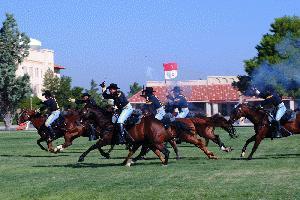 |
|---|
| In Celebration, The Cavalry Charges |
|---|
| |
|---|
 On 18 October 2005, in accordance with the Base Realignment and Closure
recommendations approved by President George W. Bush, the 4th Brigade Combat
Team, 1st Cavalry Division and its subordinate units were concurrently
activated in a ceremony at Noel Field, Ft. Bliss, Texas. In addition to the
unfurling of the Brigade colors that signified its formal reactivation and
return to duty, each of the Battalion colors were unfurled and passed to their
respective commanders.
On 18 October 2005, in accordance with the Base Realignment and Closure
recommendations approved by President George W. Bush, the 4th Brigade Combat
Team, 1st Cavalry Division and its subordinate units were concurrently
activated in a ceremony at Noel Field, Ft. Bliss, Texas. In addition to the
unfurling of the Brigade colors that signified its formal reactivation and
return to duty, each of the Battalion colors were unfurled and passed to their
respective commanders.
 The Horse Cavalry Detachment of the 1st Cavalry Division, with sabers raised
high and pistols blazing in a traditional charge, concluded the ceremony with
a reenactment of the famous "Cavalry Charge" across the very field that was
named in 1928 after Lt. Paul A. Noel, a famed polo player, who learned his
skill as a horseman while in the 1st Cavalry Division. The cavalry had come
home !! The Brigade remained remotely located at Ft. Bliss until its
return with the Division from its second deployment to Iraq.
The Horse Cavalry Detachment of the 1st Cavalry Division, with sabers raised
high and pistols blazing in a traditional charge, concluded the ceremony with
a reenactment of the famous "Cavalry Charge" across the very field that was
named in 1928 after Lt. Paul A. Noel, a famed polo player, who learned his
skill as a horseman while in the 1st Cavalry Division. The cavalry had come
home !! The Brigade remained remotely located at Ft. Bliss until its
return with the Division from its second deployment to Iraq.
 The "Standing Up" of the 4th Brigade allowed the completion of restructured of
the 1st Cavalry Division that now consisted of a War Fighting Headquarters
(UEx), staffed with approximately 1000 personnel, that provides Battle Command
and Control (BCC) of four Heavy Maneuvering Brigade Combat Teams (HBCT), a
Heavy Air Cavalry Brigade Combat Team (ACBCT), a Special Troops Battalion
(SPT) and a Support Brigade (SB). The UEx consists of Combined Command,
Control and Communications (CCCC) functions and assets formally associated
with heavy division and corps headquarter units.
The "Standing Up" of the 4th Brigade allowed the completion of restructured of
the 1st Cavalry Division that now consisted of a War Fighting Headquarters
(UEx), staffed with approximately 1000 personnel, that provides Battle Command
and Control (BCC) of four Heavy Maneuvering Brigade Combat Teams (HBCT), a
Heavy Air Cavalry Brigade Combat Team (ACBCT), a Special Troops Battalion
(SPT) and a Support Brigade (SB). The UEx consists of Combined Command,
Control and Communications (CCCC) functions and assets formally associated
with heavy division and corps headquarter units.
 The Special Troops Battalion, 4th Brigade Combat Team was first constituted on
15 May 1971 in the Regular Army as Headquarters and Headquarters Company, 4th
Brigade, 1st Cavalry Division, and activated at Ft. Hood, Texas. On 30 June
1972, it was inactivated at Ft. Hood, Texas.
The Special Troops Battalion, 4th Brigade Combat Team was first constituted on
15 May 1971 in the Regular Army as Headquarters and Headquarters Company, 4th
Brigade, 1st Cavalry Division, and activated at Ft. Hood, Texas. On 30 June
1972, it was inactivated at Ft. Hood, Texas.
 On 14 July 2005, the 4th Brigade Special Troops Battalion (BSTB) was activated
in response to the Modularity Plan employing Units of Action (UA) / Units of
Employment (UE) concept of fielding "The Objective Force" vision of of the US
Army.
On 14 July 2005, the 4th Brigade Special Troops Battalion (BSTB) was activated
in response to the Modularity Plan employing Units of Action (UA) / Units of
Employment (UE) concept of fielding "The Objective Force" vision of of the US
Army.
 On 18 October 2005, as part of the transformation of the US Army towards a
modular force the Headquarters Company, 4th Brigade, 1st Cavalry Division was
redesignated as Special Troops Battalion, 4th Brigade Combat Team, 1st Cavalry
Division, and activated at Ft. Bliss, Texas. The Headquarters of the 4th
Brigade, 1st Cavalry Division thereafter had a separate lineage. On 18 October
2005. the unit was formally activated in a ceremony at Ft. Bliss, Texas.
On 18 October 2005, as part of the transformation of the US Army towards a
modular force the Headquarters Company, 4th Brigade, 1st Cavalry Division was
redesignated as Special Troops Battalion, 4th Brigade Combat Team, 1st Cavalry
Division, and activated at Ft. Bliss, Texas. The Headquarters of the 4th
Brigade, 1st Cavalry Division thereafter had a separate lineage. On 18 October
2005. the unit was formally activated in a ceremony at Ft. Bliss, Texas.
 The 4th Special Troop Battalion forms the backbone of the 4th Brigade Combat
Team of the 1st Cavalry Division. It provides the Brigade Combat Team with
its organic Signal, Military Intelligence, and Military Police capabilities.
The battalion returned from Iraq in June 2009, and is conducting command and
control operations for the 4th Brigade Combat Team.
\
The 4th Special Troop Battalion forms the backbone of the 4th Brigade Combat
Team of the 1st Cavalry Division. It provides the Brigade Combat Team with
its organic Signal, Military Intelligence, and Military Police capabilities.
The battalion returned from Iraq in June 2009, and is conducting command and
control operations for the 4th Brigade Combat Team.
\
 The mission of the Special Troop Battalion, 4th Brigade Combat Team,
"Vigilant," is to provide intelligence, communications, and force protection
assets; command, control, and supervise of the tactical operations of the
4th Brigade Combat Team and attached units; and secure all command posts and
plans. It would also prepare and execute security operations within the 4th
Brigade Combat Team logistic and administrative support areas, with assets
provided by the 4th Brigade Combat Team Commander,to defeat level I and II
enemy threats.
The mission of the Special Troop Battalion, 4th Brigade Combat Team,
"Vigilant," is to provide intelligence, communications, and force protection
assets; command, control, and supervise of the tactical operations of the
4th Brigade Combat Team and attached units; and secure all command posts and
plans. It would also prepare and execute security operations within the 4th
Brigade Combat Team logistic and administrative support areas, with assets
provided by the 4th Brigade Combat Team Commander,to defeat level I and II
enemy threats.
 In a short one year time span, the organic companies of the Battalion were
composed of five separate, functional organizations.
In a short one year time span, the organic companies of the Battalion were
composed of five separate, functional organizations.
- "Headquarters and Headquarters" Company,- elements of the "HHC"
XXX Battalion
- The Military Police Platoon was derived using personnel
and equipment from the 545th Military Police Company.
- "A" Company, - elements from the 312th Military Intelligence
Battalion.
- "B" Company, - elements from the 13th Signal Battalion.
- "C" Company, - elements from two Engineering Battalions within the
Combat Team.
 The creation and designation of this new Special Troops Battalion, along with
the transfer and reorganization of the subordinate elements created an
organization that had earned and accrued a significant battle and campaign
history along with an impressive lineage.
The creation and designation of this new Special Troops Battalion, along with
the transfer and reorganization of the subordinate elements created an
organization that had earned and accrued a significant battle and campaign
history along with an impressive lineage.
 Operation IRAQI FREEDOM IV, 2006 - 2008
Operation IRAQI FREEDOM IV, 2006 - 2008

 On 27 July 2006 the Department of Defense announced additional major units
scheduled to deploy as part of the next Operation Iraqi Freedom rotation. The
announcement, included four Army brigades and two Marine Regimental Combat
Teams consisting of approximately 25,000 service members puts the entire 1st
Cavalry Division on orders to return to Iraq. The newly identified units of
the 1st Cavalry Division are the 1st Brigade and 4th Brigades, 1st Cavalry
Division, Fort Bliss, Texas. This rotation continues the US commitment to
Operation IRAQI FREEDOM, yet is flexible and adaptable in order to meet the
evolving requirements for the mission in Iraq.
On 27 July 2006 the Department of Defense announced additional major units
scheduled to deploy as part of the next Operation Iraqi Freedom rotation. The
announcement, included four Army brigades and two Marine Regimental Combat
Teams consisting of approximately 25,000 service members puts the entire 1st
Cavalry Division on orders to return to Iraq. The newly identified units of
the 1st Cavalry Division are the 1st Brigade and 4th Brigades, 1st Cavalry
Division, Fort Bliss, Texas. This rotation continues the US commitment to
Operation IRAQI FREEDOM, yet is flexible and adaptable in order to meet the
evolving requirements for the mission in Iraq.
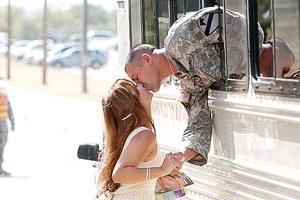 |
|---|
| Last Kiss Before Long Departure |
|---|
| |
|---|
 As of April 2006, the Special Troop Battalion, in the process of establishing
their presence at Ft. Bliss, began their deployment to Iraq, said their last
good-byes to loved ones at Ft. Bliss. They left Texas on chartered flight to
Kuwait to support the missions of the 4th Brigade Combat Team by providing
command and control for the 4th Brigade Combat Team during the conduct of
operations by employing its dual task organized command posts.
As of April 2006, the Special Troop Battalion, in the process of establishing
their presence at Ft. Bliss, began their deployment to Iraq, said their last
good-byes to loved ones at Ft. Bliss. They left Texas on chartered flight to
Kuwait to support the missions of the 4th Brigade Combat Team by providing
command and control for the 4th Brigade Combat Team during the conduct of
operations by employing its dual task organized command posts.
 On 15 November, under the clear morning skies of a promising new day the 1st
Cavalry Division took the reigns for Multi-National Division, (Task Force)
Baghdad from the 4th Infantry Division during a Transfer Of Authority Ceremony
at Camp Liberty in Baghdad, Iraq. The ceremony honored the hard work and
sacrifices of the departing 4th "Ironhorse" Infantry Division who will return
to their home base at Ft. Hood, Texas, and looked forward to future challenges
and successes to be garnered by the "First Team".
On 15 November, under the clear morning skies of a promising new day the 1st
Cavalry Division took the reigns for Multi-National Division, (Task Force)
Baghdad from the 4th Infantry Division during a Transfer Of Authority Ceremony
at Camp Liberty in Baghdad, Iraq. The ceremony honored the hard work and
sacrifices of the departing 4th "Ironhorse" Infantry Division who will return
to their home base at Ft. Hood, Texas, and looked forward to future challenges
and successes to be garnered by the "First Team".
 Lt. General Peter Chiarelli, the Commanding General of the Multi-National
Corps - no stranger to the 1st Cavalry Division, presided over the ceremony.
Less than two years ago, he had commanded the First Team during their first
rotation as MND-B. With the crisp notes of the 1st Cavalry Division band
accompanying the ceremony, Major Generalo James D. Thurman the Commanding
General of the Multi-National Division, Baghdad passed on the mantle of MND-B
with pride for his soldiers and optimism for his successors. Major General
Joseph F. Fil Jr. the Commanding General of the 1st Cavalry Division, uncased
his colors and assumed command of the MND-B mission as the Division colors
changed position in the honor guard procession.
Lt. General Peter Chiarelli, the Commanding General of the Multi-National
Corps - no stranger to the 1st Cavalry Division, presided over the ceremony.
Less than two years ago, he had commanded the First Team during their first
rotation as MND-B. With the crisp notes of the 1st Cavalry Division band
accompanying the ceremony, Major Generalo James D. Thurman the Commanding
General of the Multi-National Division, Baghdad passed on the mantle of MND-B
with pride for his soldiers and optimism for his successors. Major General
Joseph F. Fil Jr. the Commanding General of the 1st Cavalry Division, uncased
his colors and assumed command of the MND-B mission as the Division colors
changed position in the honor guard procession.

Needs Data
 On 13 August 2007 Division Headquarters announced a preliminary schedule for
the return of the troops from Iraq. A timeline for the return of units is
shown below.
On 13 August 2007 Division Headquarters announced a preliminary schedule for
the return of the troops from Iraq. A timeline for the return of units is
shown below.
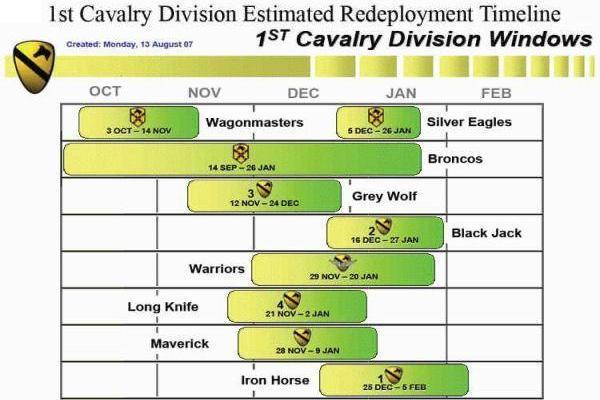 |
|---|
| Preliminary Time-Line for Return of Troops from Iraq |
|---|
| Iron Horse = 1st Brigade Combat Team |
|---|
| BlackJack - 2nd Brigade Combat Team |
|---|
| GreyWolf = 3rd Brigade Combat Team |
|---|
| LongKnife = 4th Brigade Combat Team |
|---|
| Warriors = 1st Air Cavalry Brigade |
|---|
| Maverick = Division Special Troops Battalion |
|---|
| Wagonmaster = 15th Sustainment Brigade |
|---|
| SilverEagles = 15th Finance Battalion |
|---|
| Broncos = 15th Personnel Services Battalion |
|---|
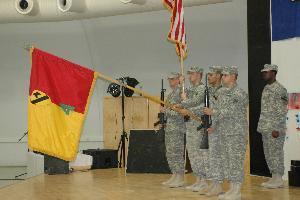 |
|---|
| 4th "LongKnife" Brigade Conducts TOA |
|---|
| |
|---|
 On 11 December during a Transfer of Authority ceremony, at Forward Operating
Base Marez. Mosul, Iraq, the 4th "Long Knife" Brigade Combat Team, 1st Cavalry
Division, handed over their responsibility for operations in northern Iraq to
the 3d Armored Cavalry Regiment from Ft. Hood, TX. The Long Knife Brigade
cased their colors for transport back to the US, following a 14-month tour
in Ninevah Province located in northern Iraq, as the 3d ACR unfurled theirs,
to symbolize assumption of control of the northern battlespace and formally
mark the beginning of their third rotation in support of Operation Iraqi
Freedom since 2003.
On 11 December during a Transfer of Authority ceremony, at Forward Operating
Base Marez. Mosul, Iraq, the 4th "Long Knife" Brigade Combat Team, 1st Cavalry
Division, handed over their responsibility for operations in northern Iraq to
the 3d Armored Cavalry Regiment from Ft. Hood, TX. The Long Knife Brigade
cased their colors for transport back to the US, following a 14-month tour
in Ninevah Province located in northern Iraq, as the 3d ACR unfurled theirs,
to symbolize assumption of control of the northern battlespace and formally
mark the beginning of their third rotation in support of Operation Iraqi
Freedom since 2003.
 Major General. Mark Hertling, commander of the 1st Armored Division, Task
Force Iron, and Multinational Division North, began the remarks by observing
how, in a bit of historic irony, the newest Brigade Combat Team of the Army
had just ceded battlefield responsibility to the oldest regiment of the Army.
With the majority of the Long Knife Brigade's Soldiers in transition to
Kuwait, or already back in the US, Col. Stephen Twitty, commander of the
Fort Bliss, Texas, based 4th Brigade Combat Team, 1st Cavalry Division,
welcomed Col. Mike Bills and the great Soldiers of the 3rd Armored Cavalry
Regiment.
Major General. Mark Hertling, commander of the 1st Armored Division, Task
Force Iron, and Multinational Division North, began the remarks by observing
how, in a bit of historic irony, the newest Brigade Combat Team of the Army
had just ceded battlefield responsibility to the oldest regiment of the Army.
With the majority of the Long Knife Brigade's Soldiers in transition to
Kuwait, or already back in the US, Col. Stephen Twitty, commander of the
Fort Bliss, Texas, based 4th Brigade Combat Team, 1st Cavalry Division,
welcomed Col. Mike Bills and the great Soldiers of the 3rd Armored Cavalry
Regiment.
 During the most recent deployment in Iraq, several reconstitutional changes
were studied, considered and since the return of the Division to Ft. Hood, TX.
from Operation Freedom IV, were implemented in order to be ready and more
prepared for their next deployment.
During the most recent deployment in Iraq, several reconstitutional changes
were studied, considered and since the return of the Division to Ft. Hood, TX.
from Operation Freedom IV, were implemented in order to be ready and more
prepared for their next deployment.
 An element of these reconstitutional changes involved the relocation of the
4th Combat Brigade, 1st Cavalry Division from the remote station of Ft. Bliss
to Ft. Hood in to central Texas. Returning to Fort Bliss in late 2007, the 4th
Brigade (LongKnives) Combat Team was inactivated, reflagged and designated as
the 4th Brigade Combat (HighLanders) Combat Team and assigned to the 1st
Armored Division on 04 March 2008.
An element of these reconstitutional changes involved the relocation of the
4th Combat Brigade, 1st Cavalry Division from the remote station of Ft. Bliss
to Ft. Hood in to central Texas. Returning to Fort Bliss in late 2007, the 4th
Brigade (LongKnives) Combat Team was inactivated, reflagged and designated as
the 4th Brigade Combat (HighLanders) Combat Team and assigned to the 1st
Armored Division on 04 March 2008.
 On 07 March, sequenced to minimize physical movenet of troops, the 4th Brigade
(Cobras) Combat Team, 4th Infantry Division at Ft. Hood, Texas was reflagged
and designated as the 4th Brigade (LongKnives) Combat Team, and assigned to
the 1st Cavalry Division. As an element of the each Brigade, the Special
Troops Battalion was included in the reflagging operations.
On 07 March, sequenced to minimize physical movenet of troops, the 4th Brigade
(Cobras) Combat Team, 4th Infantry Division at Ft. Hood, Texas was reflagged
and designated as the 4th Brigade (LongKnives) Combat Team, and assigned to
the 1st Cavalry Division. As an element of the each Brigade, the Special
Troops Battalion was included in the reflagging operations.
 Iraqi Freedom, VI 2008 - 2010
Iraqi Freedom, VI 2008 - 2010

 On 11 April 2008, the 4th Combat Brigade returned home from the Joint
Readiness Training Center at Fort Polk, LA. and is continuing their
preparation for its upcoming summer deployment in support of Operation Iraqi
Freedom. They spent almost a month at the light infantry training center
learning how to operate as small teams. The Long Knife Brigade is putting the
final touches on its deployment schedule integrating new equipment and
preparing their Soldiers for the combat zone. The unit is scheduled to
receive new vehicles and equipment, including the Mine Resistant Ambush
Protected (MRAP) vehicles in addition to new weapons including the fielding of
M-4. The M-4 carbine is a shorter weapon that is more compatible for military
operations in urban environments. Conversely, the Long Knives are scheduled to
transfer unarmored vehicles and older equipment to units remaining at Ft.
Hood.
On 11 April 2008, the 4th Combat Brigade returned home from the Joint
Readiness Training Center at Fort Polk, LA. and is continuing their
preparation for its upcoming summer deployment in support of Operation Iraqi
Freedom. They spent almost a month at the light infantry training center
learning how to operate as small teams. The Long Knife Brigade is putting the
final touches on its deployment schedule integrating new equipment and
preparing their Soldiers for the combat zone. The unit is scheduled to
receive new vehicles and equipment, including the Mine Resistant Ambush
Protected (MRAP) vehicles in addition to new weapons including the fielding of
M-4. The M-4 carbine is a shorter weapon that is more compatible for military
operations in urban environments. Conversely, the Long Knives are scheduled to
transfer unarmored vehicles and older equipment to units remaining at Ft.
Hood.
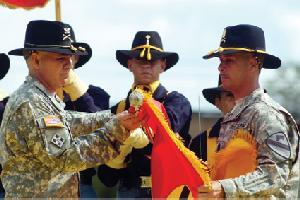 |
|---|
| 4th Brigade Cases Their Colors |
|---|
| |
|---|
 On 04 June 2008 the 4th (Longknives) Combat Brigade Team began an initial step
in their anticipated 15th month deployment by casing their colors in a
ceremony at Cooper Field Parade Grounds. Although an advanced party left
Central Texas for Iraq four days ago, the entire Brigade is not scheduled to
deploy for Operation Iraqi Freedom - VI until mid June. This deployment comes
after the soldiers of the Brigade have been undergoing extensive training for
the last 18 months, including rotations to the National Training Center at
Fort Irwin, CA in November 2007 and the Joint Readiness Training Center in
March 2008.
On 04 June 2008 the 4th (Longknives) Combat Brigade Team began an initial step
in their anticipated 15th month deployment by casing their colors in a
ceremony at Cooper Field Parade Grounds. Although an advanced party left
Central Texas for Iraq four days ago, the entire Brigade is not scheduled to
deploy for Operation Iraqi Freedom - VI until mid June. This deployment comes
after the soldiers of the Brigade have been undergoing extensive training for
the last 18 months, including rotations to the National Training Center at
Fort Irwin, CA in November 2007 and the Joint Readiness Training Center in
March 2008.
 Previously the "Long Knife" Brigade was part of the 4th Infantry Division and
deployed with it to Iraq in late 2005. As part of a reorganization between
Fort Hood, TX, Fort Bliss, TX and Fort Carson, CO the brigade was re-flagged
as a 1st Cavalry Division unit on 07 March. The former 4th Infantry soldiers
stayed at Fort Hood, but adopted the unit designations of the 1st Cavalry
Brigade, which transferred its colors from Fort Bliss, TX. The unit flags that
were cased during the ceremony of Wednesday will be unfurled in Iraq when the
unit officially assumes responsibility for the areas currently under the
control of the 82nd Airborne Brigade.
Previously the "Long Knife" Brigade was part of the 4th Infantry Division and
deployed with it to Iraq in late 2005. As part of a reorganization between
Fort Hood, TX, Fort Bliss, TX and Fort Carson, CO the brigade was re-flagged
as a 1st Cavalry Division unit on 07 March. The former 4th Infantry soldiers
stayed at Fort Hood, but adopted the unit designations of the 1st Cavalry
Brigade, which transferred its colors from Fort Bliss, TX. The unit flags that
were cased during the ceremony of Wednesday will be unfurled in Iraq when the
unit officially assumes responsibility for the areas currently under the
control of the 82nd Airborne Brigade.
 Beginning on 07 June, soldiers of the 4th Brigade Combat Team, 1st Cavalry
Division have boarded chartered aircraft at Robert Gray Army Airfield that
routinely depart for Camp Buehring, Kuwait. Camp Buehring, formerly named
Camp Udairi, is an offloading and staging post for US Military troops heading
north into Iraq. It is located in the northwestern desert of Kuwait, just 15
miles from the southern border of Iraq. The area surrounding Camp Buehring,
known as the Udairi Range Complex which is used for live fire training, is
largely uninhabited, but for a few nomadic Bedouin tribes raising camels,
goats and sheep. After adaptation to the extreme climates of the desert
environments and operational desert training in Kuwait, the Long Knife Brigade
will move forward to the interior of Iraq where they will conduct combat
missions in support of Operation Iraqi Freedom - VI.
Beginning on 07 June, soldiers of the 4th Brigade Combat Team, 1st Cavalry
Division have boarded chartered aircraft at Robert Gray Army Airfield that
routinely depart for Camp Buehring, Kuwait. Camp Buehring, formerly named
Camp Udairi, is an offloading and staging post for US Military troops heading
north into Iraq. It is located in the northwestern desert of Kuwait, just 15
miles from the southern border of Iraq. The area surrounding Camp Buehring,
known as the Udairi Range Complex which is used for live fire training, is
largely uninhabited, but for a few nomadic Bedouin tribes raising camels,
goats and sheep. After adaptation to the extreme climates of the desert
environments and operational desert training in Kuwait, the Long Knife Brigade
will move forward to the interior of Iraq where they will conduct combat
missions in support of Operation Iraqi Freedom - VI.
 On 16 June, the last of the main body of the 4th "Long Knife" Brigade Combat
Team, 1st Cavalry Division flight took off from Ft. Hood, Texas without a
hitch carrying its passengers to a 15-month deployment in Iraq. The nearly 60
Long Knife Soldiers from the 2nd Squadron, 7th Cavalry Regiment onboard the
flight to Kuwait, along with others of the brigade, will be conducting various
combat skills training to include weapon ranges before moving from Camp
Buehring, Kuwait to Iraq.
On 16 June, the last of the main body of the 4th "Long Knife" Brigade Combat
Team, 1st Cavalry Division flight took off from Ft. Hood, Texas without a
hitch carrying its passengers to a 15-month deployment in Iraq. The nearly 60
Long Knife Soldiers from the 2nd Squadron, 7th Cavalry Regiment onboard the
flight to Kuwait, along with others of the brigade, will be conducting various
combat skills training to include weapon ranges before moving from Camp
Buehring, Kuwait to Iraq.
 The flight marked the last large movement of 4th BCT troops to the combat zone
for their deployment to Operation Iraqi Freedom Rotation 08-10. With this last
main body departure, only a small trailing flight of a handful of Long Knife
Troops remain and will follow the other more than 3,500 4th BCT Soldiers to
Kuwait sometime within the next week. The training and conditioning of the 4th
at Camp Buehring, Kuwait will continue throughout the rest of June and into
early July which schedules all of the brigade to be in Iraq by mid-July as
planned.
The flight marked the last large movement of 4th BCT troops to the combat zone
for their deployment to Operation Iraqi Freedom Rotation 08-10. With this last
main body departure, only a small trailing flight of a handful of Long Knife
Troops remain and will follow the other more than 3,500 4th BCT Soldiers to
Kuwait sometime within the next week. The training and conditioning of the 4th
at Camp Buehring, Kuwait will continue throughout the rest of June and into
early July which schedules all of the brigade to be in Iraq by mid-July as
planned.
 On 23 June 2008, approximately 200 Soldiers of the advance staging party, 4th
"Long Knife" Brigade Combat Team, 1st Cavalry Division arrived at Tallil
Airbase, Iraq to begin their 15-month deployment in support of Operation IRAQ
FREEDOM - VI. (Rotation 08-10). The continuous transport and staging of other
brigade team units continued and on 14 July, the 4th Brigade Combat Team
conducted a Transfer Of Authority ceremony at Addler's Memorial Hall,
Contingency Operating Base located at Addler, Iraq relieving the command of
the 1st Brigade Combat Brigade, 82nd Airborne Division.
On 23 June 2008, approximately 200 Soldiers of the advance staging party, 4th
"Long Knife" Brigade Combat Team, 1st Cavalry Division arrived at Tallil
Airbase, Iraq to begin their 15-month deployment in support of Operation IRAQ
FREEDOM - VI. (Rotation 08-10). The continuous transport and staging of other
brigade team units continued and on 14 July, the 4th Brigade Combat Team
conducted a Transfer Of Authority ceremony at Addler's Memorial Hall,
Contingency Operating Base located at Addler, Iraq relieving the command of
the 1st Brigade Combat Brigade, 82nd Airborne Division.
 During their deployment, the Special Troops Battalion was stationed in
Southern Iraq at several different forward operating bases. The Battalion
headquarters was co-located with the Brigade Headquarters at Contingency
Operating Base Adder. The Battalion had a myriad of missions throughout the
deployment, including running Garrison Command Operations for Contingency
Operating Base Adder, as well as its primary missions in support of Brigade
operations. This included the reconnaissance, Intelligence, and surveillance
as well as providing a network which enabled command and control throughout
three separate provinces (Muthanna, Dhi Qar, and Maysan) in Southern Iraq. The
military police platoon secured the mission of training and mentoring the
Iraqi Police in the region, and the battalion was also responsible for the
Base Defense Operations Cell for Contingency Operating Base Adder.
During their deployment, the Special Troops Battalion was stationed in
Southern Iraq at several different forward operating bases. The Battalion
headquarters was co-located with the Brigade Headquarters at Contingency
Operating Base Adder. The Battalion had a myriad of missions throughout the
deployment, including running Garrison Command Operations for Contingency
Operating Base Adder, as well as its primary missions in support of Brigade
operations. This included the reconnaissance, Intelligence, and surveillance
as well as providing a network which enabled command and control throughout
three separate provinces (Muthanna, Dhi Qar, and Maysan) in Southern Iraq. The
military police platoon secured the mission of training and mentoring the
Iraqi Police in the region, and the battalion was also responsible for the
Base Defense Operations Cell for Contingency Operating Base Adder.
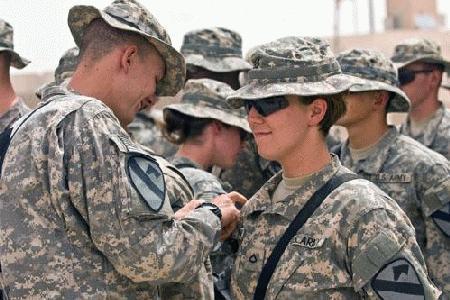 |
|---|
| Long Knifes Awarded Combat Patch |
|---|
| |
|---|
 On August 13, the commanders conducted a ceremony to recognize the sacrifices
of the Soldiers of the Spartan Battalion and Long Knife Brigade at Contingency
Operating Base Adder. In the ceremony, the 4th Brigade "Long Knife" Combat
Team, 1st Cavalry Division and their 4th Special Troop "Spartan" Battalion
deployed in support of Operation Iraqi Freedom (OIF), a little over two
months ago, officially received their combat patches.
On August 13, the commanders conducted a ceremony to recognize the sacrifices
of the Soldiers of the Spartan Battalion and Long Knife Brigade at Contingency
Operating Base Adder. In the ceremony, the 4th Brigade "Long Knife" Combat
Team, 1st Cavalry Division and their 4th Special Troop "Spartan" Battalion
deployed in support of Operation Iraqi Freedom (OIF), a little over two
months ago, officially received their combat patches.
 Although the main body of the 4th Brigade Combat Team, 1st Cavalry Division
is operating out of Camp Adder at Tallil Airbase, elements are moving to
occupy an area of southern Iraq that until now hasn't hosted American troops.
Their assigned mission is to stop weapons smuggling from Iran to Iraq. Units
like the 2nd Battalion, 7th Cavalry Regiment and the 1st Squadron, 9th Cavalry
Regiment man areas of the Iraq-Iran border and stop smugglers, They have
seized hundreds of explosively formed projectiles and improvised explosive
devices and prevented them from being used in Baghdad.
Although the main body of the 4th Brigade Combat Team, 1st Cavalry Division
is operating out of Camp Adder at Tallil Airbase, elements are moving to
occupy an area of southern Iraq that until now hasn't hosted American troops.
Their assigned mission is to stop weapons smuggling from Iran to Iraq. Units
like the 2nd Battalion, 7th Cavalry Regiment and the 1st Squadron, 9th Cavalry
Regiment man areas of the Iraq-Iran border and stop smugglers, They have
seized hundreds of explosively formed projectiles and improvised explosive
devices and prevented them from being used in Baghdad.
 The mission is one the Brigade wasn't expecting to take on, but like the
nature of the Army, the soldiers quickly adapted once they arrived in the
Middle East. Because soldiers are needed at remote locations where military
forces haven't been before, living conditions can be austere. It can be
compared to the start of the war in Iraq when soldiers were moving into areas
where forward operating bases were just being built. However, with home grown
skills, these conditions can be quickly changed.
The mission is one the Brigade wasn't expecting to take on, but like the
nature of the Army, the soldiers quickly adapted once they arrived in the
Middle East. Because soldiers are needed at remote locations where military
forces haven't been before, living conditions can be austere. It can be
compared to the start of the war in Iraq when soldiers were moving into areas
where forward operating bases were just being built. However, with home grown
skills, these conditions can be quickly changed.
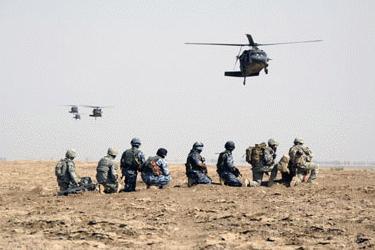 |
|---|
| I.A, & A/2/7th Conducts Operations |
|---|
| |
|---|
 On 12 September, one of the many concepts that many successful organizations
employ, teamwork came into play during a five-day mission conducted by the
5th Battalion, 82nd Field Artillery Regiment, 4th Brigade Combat, 1st Cavalry
Division. The mission, referred to by the unit as Operation CLIPPER JONES,
consisted of house-to-house searches and a series of raids to seek out and
arrest criminals and illegal weapons in northern Baghdad locations near Joint
Base Balad, Iraq.
On 12 September, one of the many concepts that many successful organizations
employ, teamwork came into play during a five-day mission conducted by the
5th Battalion, 82nd Field Artillery Regiment, 4th Brigade Combat, 1st Cavalry
Division. The mission, referred to by the unit as Operation CLIPPER JONES,
consisted of house-to-house searches and a series of raids to seek out and
arrest criminals and illegal weapons in northern Baghdad locations near Joint
Base Balad, Iraq.
 Operation CLIPPER JONES was a simple, yet very effective mission, gave them
the chance to spend more time with the locals and establish a better
perspective with the Iraqi people. The time spent with locals reaped major
benefits for the 5th Battalion, 82nd FA Regiment Soldiers when a local farmer
escorted the unit directly to a sizable weapons cache in a village near
Baghdad. He was upset about insurgents damaging his crops when conducting
hasty mortar attacks directed at the Joint Base (JB) Balad.
Operation CLIPPER JONES was a simple, yet very effective mission, gave them
the chance to spend more time with the locals and establish a better
perspective with the Iraqi people. The time spent with locals reaped major
benefits for the 5th Battalion, 82nd FA Regiment Soldiers when a local farmer
escorted the unit directly to a sizable weapons cache in a village near
Baghdad. He was upset about insurgents damaging his crops when conducting
hasty mortar attacks directed at the Joint Base (JB) Balad.
 JB Balad had earned the nickname "Mortaritaville" due to the amount mortar
fire it receives. But thanks to a recent surge of additional Soldiers in
Baghdad and the surrounding areas, the indirect fire has dramatically
decreased. Along with finding illegal weapons, the Long Knife Solders
completed mounted and dismounted patrols in areas where, historically, there
were many incidences of indirect fire and insurgent activity. Operations such
as Chipper Jones have quelled the violence in northern Baghdad, and most of
the people of Iraqi express a greater sense of security with the increased
presence of US Soldiers.
JB Balad had earned the nickname "Mortaritaville" due to the amount mortar
fire it receives. But thanks to a recent surge of additional Soldiers in
Baghdad and the surrounding areas, the indirect fire has dramatically
decreased. Along with finding illegal weapons, the Long Knife Solders
completed mounted and dismounted patrols in areas where, historically, there
were many incidences of indirect fire and insurgent activity. Operations such
as Chipper Jones have quelled the violence in northern Baghdad, and most of
the people of Iraqi express a greater sense of security with the increased
presence of US Soldiers.
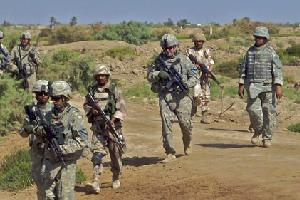 |
|---|
| Joint Operation GREENVILLE in Maysan |
|---|
| |
|---|
 On 24 September, the 1st Squadron, 9th Cavalry Regiment and 5th Battalion,
82nd Field Artillery units of the 4th Brigade Combat Team, 1st Calvary
Division set out on Operation GREENVILLE, a 4-day mission to partner with
units from the Iraqi department of border enforcement, and the 2nd Iraqi
Commando element that operates in the northern Maysan province. The mission
was unique for everyone because it was the first time the groups had worked
together, and ventured into the most northern portion of Maysan since the Long
Knife brigade arrived to Iraq in late June.
On 24 September, the 1st Squadron, 9th Cavalry Regiment and 5th Battalion,
82nd Field Artillery units of the 4th Brigade Combat Team, 1st Calvary
Division set out on Operation GREENVILLE, a 4-day mission to partner with
units from the Iraqi department of border enforcement, and the 2nd Iraqi
Commando element that operates in the northern Maysan province. The mission
was unique for everyone because it was the first time the groups had worked
together, and ventured into the most northern portion of Maysan since the Long
Knife brigade arrived to Iraq in late June.
 A hugely successful first encounter with great potential to further develop
relationships with some outstanding Iraqi Soldiers, the Soldiers departed
Forward Operating Base Hunter before sunrise, and quickly set up their
headquarters in the sandy northern desert where the Head Hunter and 5-82
Bulldog Soldiers could perform area reconnaissance. This was an important
step, as the Long Knife Soldier and Iraqi elements searched houses and
buildings as one team to build partnerships in the area.
A hugely successful first encounter with great potential to further develop
relationships with some outstanding Iraqi Soldiers, the Soldiers departed
Forward Operating Base Hunter before sunrise, and quickly set up their
headquarters in the sandy northern desert where the Head Hunter and 5-82
Bulldog Soldiers could perform area reconnaissance. This was an important
step, as the Long Knife Soldier and Iraqi elements searched houses and
buildings as one team to build partnerships in the area.
 The terrain was quite diverse in the desert, with mountains to the south,
reminding the Soldiers of their mission readiness exercise last winter at the
National Training Center in Fort Irwin, CA. The major difference being the
fact that along many roads in northern Mayson, you can see the Iranian
soldiers guarding their territory on the other side of the Iraq-Iran border.
The population of the area was extremely sparse, with the majority of the
local nationals who are oil field workers, perform the tasks required to bring
the vast natural resource to market, which helps the country become stable
economically.
The terrain was quite diverse in the desert, with mountains to the south,
reminding the Soldiers of their mission readiness exercise last winter at the
National Training Center in Fort Irwin, CA. The major difference being the
fact that along many roads in northern Mayson, you can see the Iranian
soldiers guarding their territory on the other side of the Iraq-Iran border.
The population of the area was extremely sparse, with the majority of the
local nationals who are oil field workers, perform the tasks required to bring
the vast natural resource to market, which helps the country become stable
economically.
 Though Operation GREENVILLE was mainly designed to locate Improvised
Explosive Devices (IED) and other unexploded ordnances in the area, the Long
Knife and Iraqi soldiers were also expecting to uncover bombs and land mines
left over from the Iran-Iraq war. During their mission, the Coalition Forces
patrolled more than 1000 miles, visited 12 Iraqi Border towns and acquired
loads of valuable information that should be useful in future missions.
Though Operation GREENVILLE was mainly designed to locate Improvised
Explosive Devices (IED) and other unexploded ordnances in the area, the Long
Knife and Iraqi soldiers were also expecting to uncover bombs and land mines
left over from the Iran-Iraq war. During their mission, the Coalition Forces
patrolled more than 1000 miles, visited 12 Iraqi Border towns and acquired
loads of valuable information that should be useful in future missions.
 On 28 September, Soldiers of the 38th Iraqi Army (IA) Brigade and the 2nd
Battalion, 7th Cavalry Regiment, 4th Brigade Combat Team, 1st Cavalry Division
completed their second combined tactical air insertion in the Amarah, Iraq
area. The 38th IA is focused on reaching the tribal villages in some of the
more remote areas of the Maysan Province. The ability to move by air allows
the Soldiers to search areas seldom patrolled by coalition forces. The 2nd
Battalion, which has partnered with the 38th IA Brigade. for the last three
months, continues to support the IA units while conducting counter-smuggling
operations along the Iraq-Iran border.
On 28 September, Soldiers of the 38th Iraqi Army (IA) Brigade and the 2nd
Battalion, 7th Cavalry Regiment, 4th Brigade Combat Team, 1st Cavalry Division
completed their second combined tactical air insertion in the Amarah, Iraq
area. The 38th IA is focused on reaching the tribal villages in some of the
more remote areas of the Maysan Province. The ability to move by air allows
the Soldiers to search areas seldom patrolled by coalition forces. The 2nd
Battalion, which has partnered with the 38th IA Brigade. for the last three
months, continues to support the IA units while conducting counter-smuggling
operations along the Iraq-Iran border.
 The combined patrol canvassed three different villages where the Iraqi and
American patrol leaders met with local national officials. The leaders
identified ways to work together to bring greater progress to the more
isolated areas of the province. Members of the patrol also handed out fliers
promoting the Coalition tips line, which is used by locals to report smuggling
and any suspicious activity. The partnered units will continue to operate
throughout Maysan as they work in coordination with the provincial government
to integrate tribal villages.
The combined patrol canvassed three different villages where the Iraqi and
American patrol leaders met with local national officials. The leaders
identified ways to work together to bring greater progress to the more
isolated areas of the province. Members of the patrol also handed out fliers
promoting the Coalition tips line, which is used by locals to report smuggling
and any suspicious activity. The partnered units will continue to operate
throughout Maysan as they work in coordination with the provincial government
to integrate tribal villages.
 On 09 October, the Commander of the 4th Brigade Combat Team indicated that
operations of US led forces in southeastern Iraq have disrupted a major
arms-smuggling network blamed for distributing deadly Iranian-made roadside
bombs and rockets in Iraq. The Brigade has committed 1,800 troops or more than
half of their 3,500 strong force to Iraq's Maysan border province north of
Basra. Since their deployment to Iraq in July, the Brigade has seized more
than 8,000 weapons crossing into Iraq from Iran, including about 600
Explosively Formed Penetrators or Projectiles (EFPs) and a number of
Iranian-made rockets. EFPs, which can pierce armor, are a particularly deadly
form of roadside bomb. US officials have accused the Iranian Revolutionary
Guards' elite Qods force of supplying those munitions as well as rockets to
Shi'ite militias in Iraq for attacks on US and Iraqi forces.
On 09 October, the Commander of the 4th Brigade Combat Team indicated that
operations of US led forces in southeastern Iraq have disrupted a major
arms-smuggling network blamed for distributing deadly Iranian-made roadside
bombs and rockets in Iraq. The Brigade has committed 1,800 troops or more than
half of their 3,500 strong force to Iraq's Maysan border province north of
Basra. Since their deployment to Iraq in July, the Brigade has seized more
than 8,000 weapons crossing into Iraq from Iran, including about 600
Explosively Formed Penetrators or Projectiles (EFPs) and a number of
Iranian-made rockets. EFPs, which can pierce armor, are a particularly deadly
form of roadside bomb. US officials have accused the Iranian Revolutionary
Guards' elite Qods force of supplying those munitions as well as rockets to
Shi'ite militias in Iraq for attacks on US and Iraqi forces.
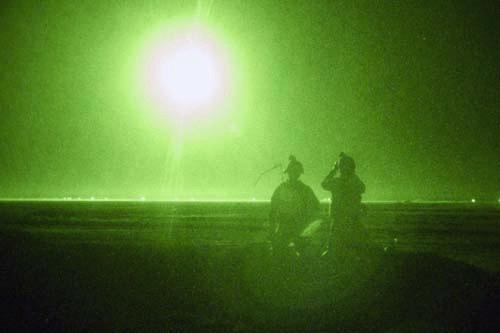 |
|---|
| Artillery Rounds Light Up The Night Sky |
|---|
| |
|---|
 On 04 November a small team of forward observers from the 4th Brigade, 1st
Cavalry Division went to the outskirts of a small town Nasiriyah, located just
outside the Contingency Operation Base of Adder, Iraq with the Romanian
artillery troops from the 341st Infantry Battalion to observe the movements
of the local citizens and their activitivies. The surveying of landscape for
criminals in the outskirts of Nasiriyah has become a team effort for the Long
Knife Brigade and its Romanian White Shark Battalion partners.
On 04 November a small team of forward observers from the 4th Brigade, 1st
Cavalry Division went to the outskirts of a small town Nasiriyah, located just
outside the Contingency Operation Base of Adder, Iraq with the Romanian
artillery troops from the 341st Infantry Battalion to observe the movements
of the local citizens and their activitivies. The surveying of landscape for
criminals in the outskirts of Nasiriyah has become a team effort for the Long
Knife Brigade and its Romanian White Shark Battalion partners.
 The group travelled down a long highway for an hour before leaving the main
roadways for dirt roads and small villages, filled with children and farm
animals being attended to by the adults in the area. The American and Romanian
team found an area of the open desert where they could easily maintain
proper security and maintain a good view of the surrounding areas. The Long
Knife artillery team brought a night vision device that provided the ability
to easily see objects hundreds of meters away, even in the low visibility
conditions. The team agreed that working with the Romanians, as they are among
the few forward observers to work directly with troops of another country,
brings an honor they will always remember. Just after nightfall, the 4th
Brigade Combat Team artillerymen, set up their equipment and began observation
of the local Iraqi citizens during normal evening activities.
The group travelled down a long highway for an hour before leaving the main
roadways for dirt roads and small villages, filled with children and farm
animals being attended to by the adults in the area. The American and Romanian
team found an area of the open desert where they could easily maintain
proper security and maintain a good view of the surrounding areas. The Long
Knife artillery team brought a night vision device that provided the ability
to easily see objects hundreds of meters away, even in the low visibility
conditions. The team agreed that working with the Romanians, as they are among
the few forward observers to work directly with troops of another country,
brings an honor they will always remember. Just after nightfall, the 4th
Brigade Combat Team artillerymen, set up their equipment and began observation
of the local Iraqi citizens during normal evening activities.
 Vision became greatly improved as the first illumination artillery rounds were
launched from COB Adder, lighting up the sky as though the sun was beginning
to rise, and the team began to notice a vehicle with a handful of suspicious
looking men. The illumination rounds did their job of detouring criminal
actions and improving visibility, as the suspicious group fled the scene. The
group observed a second volley of illumination rounds just in time for the
observers to confirm whether the group was preparing to do harm or if they
were only on a routine trip outside of town. The joint Romanian and American
artillery teams spent the remainder of the night observing the area and
improving their relationship as coalition partners.
Vision became greatly improved as the first illumination artillery rounds were
launched from COB Adder, lighting up the sky as though the sun was beginning
to rise, and the team began to notice a vehicle with a handful of suspicious
looking men. The illumination rounds did their job of detouring criminal
actions and improving visibility, as the suspicious group fled the scene. The
group observed a second volley of illumination rounds just in time for the
observers to confirm whether the group was preparing to do harm or if they
were only on a routine trip outside of town. The joint Romanian and American
artillery teams spent the remainder of the night observing the area and
improving their relationship as coalition partners.
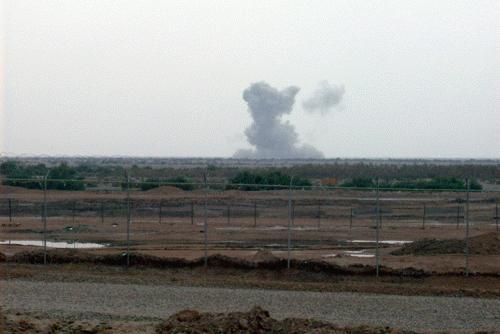 |
|---|
| Newly Formed EOD Team Detonates TNT |
|---|
| |
|---|
 On 07 November, an Explosives Ordnance Disposal (EOD) Team, assigned to the
4th Brigade Combat Team, 1st Cavalry Division traveled from Contingency
Operating Base Adder, Iraq to Combat Outpost Six to train the newly-formed
10th Iraqi Army EOD team. Prior to the formation of the Iraqi EOD team, the
Iraqis depended primarily on Coalition forces to provide ordnance disposal
over the past five years. Iraq and its Army takes one more step toward
self-sufficiency by building its own EOD units, in each of the provinces, with
assistance from the 4th BCT, to ensure the units are trained and equipped to
handle such dangerous missions.
On 07 November, an Explosives Ordnance Disposal (EOD) Team, assigned to the
4th Brigade Combat Team, 1st Cavalry Division traveled from Contingency
Operating Base Adder, Iraq to Combat Outpost Six to train the newly-formed
10th Iraqi Army EOD team. Prior to the formation of the Iraqi EOD team, the
Iraqis depended primarily on Coalition forces to provide ordnance disposal
over the past five years. Iraq and its Army takes one more step toward
self-sufficiency by building its own EOD units, in each of the provinces, with
assistance from the 4th BCT, to ensure the units are trained and equipped to
handle such dangerous missions.
 Organization and training of these newly formed EOD groups is another step
forward for the Iraqi Security Forces in Muthana. It makes them more
self-sufficient and encourages them to take on greater responsibility and
tougher missions, without Coalition support. The training started with
classroom instruction, then elevated to hands-on practical exercises and
culminated with a live detonation of a cache of TNT previously found and
confiscated during a mission. The event provided another step on the road to
a trained, professional Iraqi security force able to carry out stability
operations in southern Iraq.
Organization and training of these newly formed EOD groups is another step
forward for the Iraqi Security Forces in Muthana. It makes them more
self-sufficient and encourages them to take on greater responsibility and
tougher missions, without Coalition support. The training started with
classroom instruction, then elevated to hands-on practical exercises and
culminated with a live detonation of a cache of TNT previously found and
confiscated during a mission. The event provided another step on the road to
a trained, professional Iraqi security force able to carry out stability
operations in southern Iraq.
 On 10 November, the 5th Battalion, 82nd Field Artillery Battalion, 4th
Brigade Combat Team, 1st Cavalry Division returned to the First Team's fold
after spending the first few months in Balad where their initial mission was
securing a key airport north of Baghdad.
On 10 November, the 5th Battalion, 82nd Field Artillery Battalion, 4th
Brigade Combat Team, 1st Cavalry Division returned to the First Team's fold
after spending the first few months in Balad where their initial mission was
securing a key airport north of Baghdad.
 On 15 November leaders from the Iraqi Army, Iraqi Police and Iraqi Border
Patrol met with Coalition leaders for the first time in the Maysan Province,
near the provincial capital of Amarah. For weeks in advance, the 4th Brigade
Combat Team, 1st Cavalry Division leaders worked behind the scenes to bring
commanders from the 11th Border Enforcement, the 38th and 41st Iraqi Army
Brigades and the Maysan Police together. The Long Knife Brigade shared
information on suspected criminal activity and provided plans for future
cooperative efforts to increase border security in the province. Up to this
point, the border patrol, Iraqi Police and Iraqi Army have done great work in
securing the province.The conference represented a huge step toward
synchronizing all those successes to close security gaps and secure the
province as a whole.
On 15 November leaders from the Iraqi Army, Iraqi Police and Iraqi Border
Patrol met with Coalition leaders for the first time in the Maysan Province,
near the provincial capital of Amarah. For weeks in advance, the 4th Brigade
Combat Team, 1st Cavalry Division leaders worked behind the scenes to bring
commanders from the 11th Border Enforcement, the 38th and 41st Iraqi Army
Brigades and the Maysan Police together. The Long Knife Brigade shared
information on suspected criminal activity and provided plans for future
cooperative efforts to increase border security in the province. Up to this
point, the border patrol, Iraqi Police and Iraqi Army have done great work in
securing the province.The conference represented a huge step toward
synchronizing all those successes to close security gaps and secure the
province as a whole.
 Three of the battalions from the Long Knife Brigades are operating in Maysan.
The 1st Squadron, 9th Cavalry Regiment is partnered with the border patrol
element to interdict munitions and arrest criminals crossing from Iran into
Iraq. The 2nd Battalion, 7th Cavalry Regiment is partnered with the 38th IA
Brigade and the 5th Battalion, 82nd Field Artillery Regiment is partnered with
the 41st IA Brigade. During these combined operations, the Iraqi Security
Forces in southern Iraq have arrested approximately 200 suspected criminals
and seized more than 9,000 various munitions, including Improvised Explosive
Devices and Explosively Formed Projectile Materials, since the Long Knife
Brigade arrived this summer.
Three of the battalions from the Long Knife Brigades are operating in Maysan.
The 1st Squadron, 9th Cavalry Regiment is partnered with the border patrol
element to interdict munitions and arrest criminals crossing from Iran into
Iraq. The 2nd Battalion, 7th Cavalry Regiment is partnered with the 38th IA
Brigade and the 5th Battalion, 82nd Field Artillery Regiment is partnered with
the 41st IA Brigade. During these combined operations, the Iraqi Security
Forces in southern Iraq have arrested approximately 200 suspected criminals
and seized more than 9,000 various munitions, including Improvised Explosive
Devices and Explosively Formed Projectile Materials, since the Long Knife
Brigade arrived this summer.
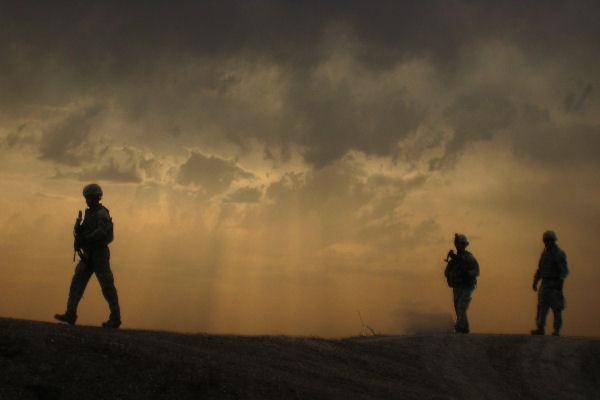 |
|---|
| IA Solders Conduct Dismounted Patrol |
|---|
| |
|---|
 On 24 February the 5th Battalion, 82nd Field Artillery Regiment, also known as
"Black Dragons," teamed up with the 41st Brigade, 10th Iraqi Army (IA)
Division for Operation LONG ISLAND with the intent of duplicating the results
of patrolling in northern Baghdad last summer where they reduced the rate of
indirect fire received at the base to its lowest levels since the war started
in 2003.
On 24 February the 5th Battalion, 82nd Field Artillery Regiment, also known as
"Black Dragons," teamed up with the 41st Brigade, 10th Iraqi Army (IA)
Division for Operation LONG ISLAND with the intent of duplicating the results
of patrolling in northern Baghdad last summer where they reduced the rate of
indirect fire received at the base to its lowest levels since the war started
in 2003.
 The training programs provided by the "Black Dragons" at Camp Dhi Qar and the
Besmaya Range Complex, which is where all IA Division units do their final
training before being considered ready to conduct operations in southern Iraq,
helped lay the foundation for an effective partnership between the "Black
Dragons" and IA Division units. The training involved vehicle and foot
patrols, searching vehicles and personnel at checkpoints coupled with
small-arms qualification.
The training programs provided by the "Black Dragons" at Camp Dhi Qar and the
Besmaya Range Complex, which is where all IA Division units do their final
training before being considered ready to conduct operations in southern Iraq,
helped lay the foundation for an effective partnership between the "Black
Dragons" and IA Division units. The training involved vehicle and foot
patrols, searching vehicles and personnel at checkpoints coupled with
small-arms qualification.
 By enabling the Iraqi troops to take the lead during joint patrols, the IA
Division Soldiers became better prepared to interdict and help in the
continued steady decline of violence in the Maysan Province. The Black Dragons
look forward to continued joint training and patrols with their new Iraqi
partners, which will lead to the reduction of the amount of indirect fire
focused on FOB Hunter.
By enabling the Iraqi troops to take the lead during joint patrols, the IA
Division Soldiers became better prepared to interdict and help in the
continued steady decline of violence in the Maysan Province. The Black Dragons
look forward to continued joint training and patrols with their new Iraqi
partners, which will lead to the reduction of the amount of indirect fire
focused on FOB Hunter.
 On 02 March, the 5th Battalion, 82nd Field Artillery Regiment, was tasked to
assume responsibility of battle space near the operating base of Forward
Operating Base (FOB) Hunter, Iraq, build a new home and move in - all at the
same time. In movements beginning at their initial deployment in June 2008,
the unit had Soldiers spread out from northern Baghdad to southern Iraq with
missions ranging from counter-fire to maintaining a military presence in a
joint-defense-operations center.
On 02 March, the 5th Battalion, 82nd Field Artillery Regiment, was tasked to
assume responsibility of battle space near the operating base of Forward
Operating Base (FOB) Hunter, Iraq, build a new home and move in - all at the
same time. In movements beginning at their initial deployment in June 2008,
the unit had Soldiers spread out from northern Baghdad to southern Iraq with
missions ranging from counter-fire to maintaining a military presence in a
joint-defense-operations center.
 After providing base security just north of Baghdad, then training a new Iraqi
Army brigade in southern Iraq, the 'Black Dragons' of the 4th Brigade Combat
Team, 1st Cavalry Division, were once again on the move. With FOB Hunter
nearing its maximum capacity, the Black Dragon Soldiers worked to expand the
base to house their unit. Meanwhile, the battalion continued its partnership
with its Iraqi artillery counterparts, the 41st Brigade, 10th Iraqi Army
Division in protecting the Iraqi people of Maysan. The Black Dragons are
scheduled to complete their deployment by late summer, but for now they're
lighting up the Iraqi sky with illumination rounds and ready to make a
positive impact in Maysan.
After providing base security just north of Baghdad, then training a new Iraqi
Army brigade in southern Iraq, the 'Black Dragons' of the 4th Brigade Combat
Team, 1st Cavalry Division, were once again on the move. With FOB Hunter
nearing its maximum capacity, the Black Dragon Soldiers worked to expand the
base to house their unit. Meanwhile, the battalion continued its partnership
with its Iraqi artillery counterparts, the 41st Brigade, 10th Iraqi Army
Division in protecting the Iraqi people of Maysan. The Black Dragons are
scheduled to complete their deployment by late summer, but for now they're
lighting up the Iraqi sky with illumination rounds and ready to make a
positive impact in Maysan.
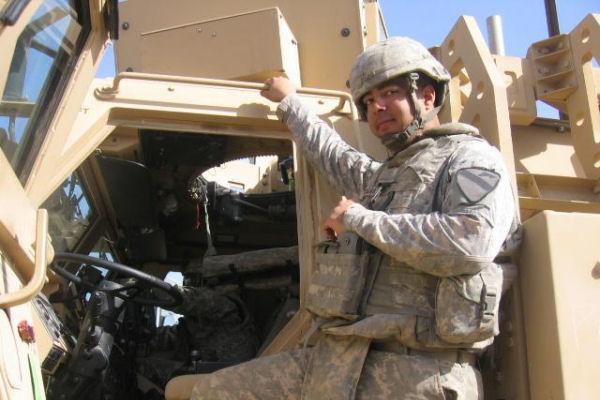 |
|---|
| Troopers Depart Security Station Apache |
|---|
| |
|---|
 On 16th March, Troopers of the distribution and maintenance platoons, 1st
Squadron, 9th Cavalry Regiment began a mission that is repeated every week in
the Maysan Province - taking to the roads delivering critical supplies to
support the rest of the unit. The average trip for the 4th Brigade Combat
Team, 1st Cavalry Division can take days depending on the load and distance.
However, without these supplies, the Squadron would not be able to patrol the
south-eastern border of Iraq to intercept illegal weapon-smuggling.
On 16th March, Troopers of the distribution and maintenance platoons, 1st
Squadron, 9th Cavalry Regiment began a mission that is repeated every week in
the Maysan Province - taking to the roads delivering critical supplies to
support the rest of the unit. The average trip for the 4th Brigade Combat
Team, 1st Cavalry Division can take days depending on the load and distance.
However, without these supplies, the Squadron would not be able to patrol the
south-eastern border of Iraq to intercept illegal weapon-smuggling.
 The average patrol starts 24 hours before departing. The Troopers load their
flat-bed vehicles, water tankers and fuel trucks with supplies available for
transport. When the loading is completed they conduct pre-combat checks and
rehearse every phase of the operation. Once rehearsals are complete, the unit
requires at least eight hours of rest to ensure they are fully prepared for
the long mission ahead.
The average patrol starts 24 hours before departing. The Troopers load their
flat-bed vehicles, water tankers and fuel trucks with supplies available for
transport. When the loading is completed they conduct pre-combat checks and
rehearse every phase of the operation. Once rehearsals are complete, the unit
requires at least eight hours of rest to ensure they are fully prepared for
the long mission ahead.
 In traveling along the dusty roads of southern Iraq, along the Iranian border,
the Soldiers pass through many rural towns and villages. During each phase of
the convoy, the Head Hunters rely on their discipline and training to be
considerate of the Iraqi citizens of Maysan Province. Each time the brave
soldiers of the distribution and maintenance platoons take to the road in
support of the Squadron, they risk their lives while improving the lives of
the people of Iraq.
In traveling along the dusty roads of southern Iraq, along the Iranian border,
the Soldiers pass through many rural towns and villages. During each phase of
the convoy, the Head Hunters rely on their discipline and training to be
considerate of the Iraqi citizens of Maysan Province. Each time the brave
soldiers of the distribution and maintenance platoons take to the road in
support of the Squadron, they risk their lives while improving the lives of
the people of Iraq.
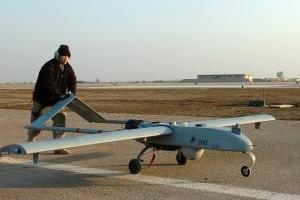 |
|---|
| Moving UAV To Launching Area |
|---|
| |
|---|
 On 31 March, the 4th Special Troops Battalion, 4th Brigade Combat Team, 1st
Cavalry Division's Unmanned Aerial System (UAS) Platoon began using the
high-flying, remotely-piloted aircraft to provide real-time imagery along the
southeastern border of Iraq. The UAS troops were stationed at Contingency
Operating Base Adder when the brigade took responsibility for southern
tri-province areas of Dhi-qar, Muthana, and Maysan of Iraq in late June 2008.
As the brigade began to expand operations, the Spartan soldiers deployed to
Forward Operating Bases (FOB) Garry Owen and Hunter to use their extensive
"eye in the sky" visuals to monitor the brigade's ground troops and provide
increased force protection capabilities.
On 31 March, the 4th Special Troops Battalion, 4th Brigade Combat Team, 1st
Cavalry Division's Unmanned Aerial System (UAS) Platoon began using the
high-flying, remotely-piloted aircraft to provide real-time imagery along the
southeastern border of Iraq. The UAS troops were stationed at Contingency
Operating Base Adder when the brigade took responsibility for southern
tri-province areas of Dhi-qar, Muthana, and Maysan of Iraq in late June 2008.
As the brigade began to expand operations, the Spartan soldiers deployed to
Forward Operating Bases (FOB) Garry Owen and Hunter to use their extensive
"eye in the sky" visuals to monitor the brigade's ground troops and provide
increased force protection capabilities.
 The platoon initially moved a section of troops to Garry Owen in September to
support the 2nd Battalion, 7th Cavalry Regiment soldiers with long-range UAV
coverage in the city of Al Amarah. In early October, the 21-man platoon was
on the move again to Forward Operating Base Hunter located in southern Maysan
Province. The 1st Squadron, 9th Cavalry Regiment soldiers worked closely with
the UAS platoon, while the soldiers provided aerial coverage for the entire
Maysan province.
The platoon initially moved a section of troops to Garry Owen in September to
support the 2nd Battalion, 7th Cavalry Regiment soldiers with long-range UAV
coverage in the city of Al Amarah. In early October, the 21-man platoon was
on the move again to Forward Operating Base Hunter located in southern Maysan
Province. The 1st Squadron, 9th Cavalry Regiment soldiers worked closely with
the UAS platoon, while the soldiers provided aerial coverage for the entire
Maysan province.
 Also on 31 March 2009, the 1st Cavalry Division officials addressed soldiers
and family members during the division's first town hall meeting night,
tackling topics from deployment lengths to recreation facilities for deployed
soldiers. The meeting was led by Lt. Col. (promotable) Jeffrey Sauer, the
Division's rear detachment commander, at Ft. Hood while Major General Daniel
Bolger and Command Sgt. Major Rory Malloy gave updates and answered questions
live from Baghdad, Iraq.
Also on 31 March 2009, the 1st Cavalry Division officials addressed soldiers
and family members during the division's first town hall meeting night,
tackling topics from deployment lengths to recreation facilities for deployed
soldiers. The meeting was led by Lt. Col. (promotable) Jeffrey Sauer, the
Division's rear detachment commander, at Ft. Hood while Major General Daniel
Bolger and Command Sgt. Major Rory Malloy gave updates and answered questions
live from Baghdad, Iraq.
 During the meeting, it was confirmed that the 4th Brigade Combat Team is
scheduled to come home in June, 12 months after they soldiers left Ft. Hood
and block leave for the brigade's soldiers will begin 20 June. None of the
soldiers, currently in Iraq, will be sent to Afghanistan to complete their
deployments that are currently scheduled for 12 months.
During the meeting, it was confirmed that the 4th Brigade Combat Team is
scheduled to come home in June, 12 months after they soldiers left Ft. Hood
and block leave for the brigade's soldiers will begin 20 June. None of the
soldiers, currently in Iraq, will be sent to Afghanistan to complete their
deployments that are currently scheduled for 12 months.
 The information officers did provide some information about the organization
of the Division throughout Iraq. The Special Troops Battalion and 1st Brigade
Combat Team are in the capital where the Division serves as head of
Multinational Division-Baghdad. The 2nd Brigade Combat Team is in Kirkuk, the
3rd Brigade Combat Team is in Mosul, and the 4th Brigade Combat Team is
located in the southeastern part of Iraq.
The information officers did provide some information about the organization
of the Division throughout Iraq. The Special Troops Battalion and 1st Brigade
Combat Team are in the capital where the Division serves as head of
Multinational Division-Baghdad. The 2nd Brigade Combat Team is in Kirkuk, the
3rd Brigade Combat Team is in Mosul, and the 4th Brigade Combat Team is
located in the southeastern part of Iraq.
 The Special Troops Battalion and 1st Brigade are the only two 1st Cavalry
units in Multinational Division-Baghdad. The 2nd and 3rd Brigades are
operating under the control of the 25th Infantry Division, and the 4th Brigade
reports to the 10th Mountain Division with over half the units located on
small patrol bases, combat outposts or joint security stations.
The Special Troops Battalion and 1st Brigade are the only two 1st Cavalry
units in Multinational Division-Baghdad. The 2nd and 3rd Brigades are
operating under the control of the 25th Infantry Division, and the 4th Brigade
reports to the 10th Mountain Division with over half the units located on
small patrol bases, combat outposts or joint security stations.
 Also, on 23 April, at Contingency Operating Base, Adder, near Nasiriyah, Iraq,
it was announced that the 4th Brigade Combat Team, will begin returning to Ft.
Hood next month after its year-long tour in Iraq. The 4th BCT has been
operating in southern Iraq in three provinces: Dhi Qar, Muthanna and Maysan.
They have partnered with Iraqi Security Forces to improve security and support
civil developments of the region.
Also, on 23 April, at Contingency Operating Base, Adder, near Nasiriyah, Iraq,
it was announced that the 4th Brigade Combat Team, will begin returning to Ft.
Hood next month after its year-long tour in Iraq. The 4th BCT has been
operating in southern Iraq in three provinces: Dhi Qar, Muthanna and Maysan.
They have partnered with Iraqi Security Forces to improve security and support
civil developments of the region.
 The Brigade was originally scheduled to return in September, but with the
improved security conditions in the area of operations controlled by the
brigade has allowed Army leaders to redeploy the brigade at the end of the
one-year mark. Flights carrying the main group of the brigade are scheduled to
arrive at Ft. Hood during the latter part of May, with the entire unit
scheduled to return by mid-June.
The Brigade was originally scheduled to return in September, but with the
improved security conditions in the area of operations controlled by the
brigade has allowed Army leaders to redeploy the brigade at the end of the
one-year mark. Flights carrying the main group of the brigade are scheduled to
arrive at Ft. Hood during the latter part of May, with the entire unit
scheduled to return by mid-June.
 Key training sessions for comprehensive safety and reintegration program
started in Iraq will be continued after the unit returns home to ensure a
seamless transition. The sessions will address the usual concerns voiced by
Soldiers after returning from a combat tour, such as redeployment, leave, and
healthcare to prepare the troopers to adjust to life back at home. The brigade
will host a ceremony to uncase its colors at the end of the normal block leave
in late July.
Key training sessions for comprehensive safety and reintegration program
started in Iraq will be continued after the unit returns home to ensure a
seamless transition. The sessions will address the usual concerns voiced by
Soldiers after returning from a combat tour, such as redeployment, leave, and
healthcare to prepare the troopers to adjust to life back at home. The brigade
will host a ceremony to uncase its colors at the end of the normal block leave
in late July.
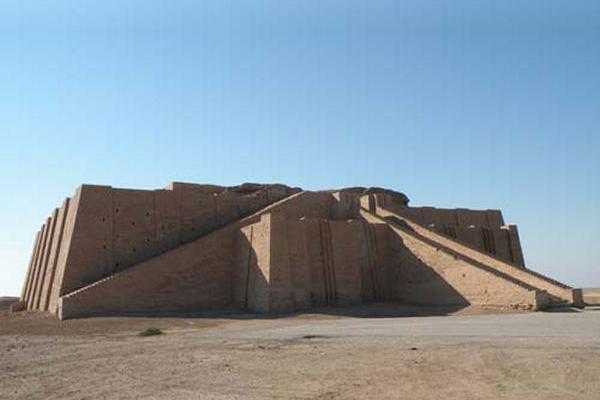 |
|---|
| Ziggurat - Located At The City Of Ur, Iraq |
|---|
|  |
|---|
 On 13 May, the 4th Brigade Combat Team, 1st Cavalry Division transferred back
the 5,000-year-old Ziggurat of Ur, one of Iraq’s most famous archeological
sites, to the protection of Iraqi security forces. The Ziggurat, a multi-level
pyramid believed to have a religious significance, is in Dhi Qar province in
southeastern Iraq. The site is now under the control of the Dhi Qar police
and under the management of the Ministry of Tourism.
On 13 May, the 4th Brigade Combat Team, 1st Cavalry Division transferred back
the 5,000-year-old Ziggurat of Ur, one of Iraq’s most famous archeological
sites, to the protection of Iraqi security forces. The Ziggurat, a multi-level
pyramid believed to have a religious significance, is in Dhi Qar province in
southeastern Iraq. The site is now under the control of the Dhi Qar police
and under the management of the Ministry of Tourism.
 The Dhi Qar Provincial Reconstruction Team and the 4th Brigade Combat Team,
assisted the Iraqi security forces and the Antiquities in Nasiryah, to plan
the event, which included various government officials and military leaders
throughout central and southern Iraq.
The Dhi Qar Provincial Reconstruction Team and the 4th Brigade Combat Team,
assisted the Iraqi security forces and the Antiquities in Nasiryah, to plan
the event, which included various government officials and military leaders
throughout central and southern Iraq.
 Coalition forces have had control of the structure since 2003. They turned it
over to Iraqis in a ceremony attended by government and military leaders at
Contingency Operating Base Adder. The transfer is one of the final acts of
partnership between Iraqi forces and the 4th Brigade Combat Team, who has
already began their rotation home, returning to Ft. Hood, TX.
Coalition forces have had control of the structure since 2003. They turned it
over to Iraqis in a ceremony attended by government and military leaders at
Contingency Operating Base Adder. The transfer is one of the final acts of
partnership between Iraqi forces and the 4th Brigade Combat Team, who has
already began their rotation home, returning to Ft. Hood, TX.
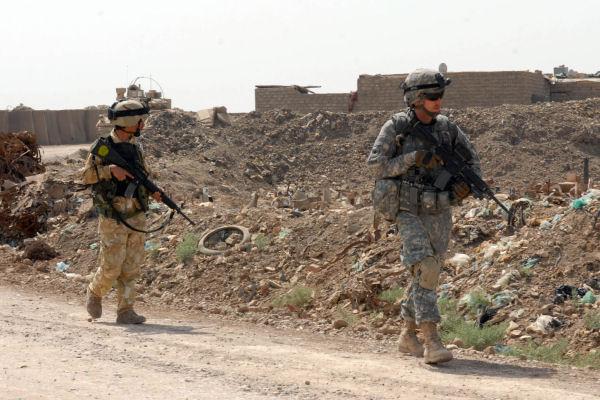 |
|---|
| Joint Colation Forces and ISF Patrols |
|---|
|  |
|---|
 On 18 May, deesignated members of 1st Cavalry Division joined with the Iraqi
Security Forces (ISF) in an effort to update the ISF with all necessary
knowledge, training, and experience which will provide a more safe, stable and
secure Iraq before they are required to pull back (from Iraq cities and
villages) by 30 June in accordance with the security agreement. As an example
of this effort, Soldiers from "A" Company, 2nd Battalion, 5th Cavalry
Regiment, 1st Brigade Combat Team and the 3rd Battalion, 44th Brigade, 11th
Iraqi Army (IA) Division, operating out of Joint Security Station Ur, joined
in a joint security patrol in Hamandiyah, in northeast Baghdad.
On 18 May, deesignated members of 1st Cavalry Division joined with the Iraqi
Security Forces (ISF) in an effort to update the ISF with all necessary
knowledge, training, and experience which will provide a more safe, stable and
secure Iraq before they are required to pull back (from Iraq cities and
villages) by 30 June in accordance with the security agreement. As an example
of this effort, Soldiers from "A" Company, 2nd Battalion, 5th Cavalry
Regiment, 1st Brigade Combat Team and the 3rd Battalion, 44th Brigade, 11th
Iraqi Army (IA) Division, operating out of Joint Security Station Ur, joined
in a joint security patrol in Hamandiyah, in northeast Baghdad.
 Coalition Forces operate hand-in-hand with the Government of Iraq (GOI) and
Iraqi Security Forces (ISF). All missions are conducted as joint efforts
between Coalition Forces and the ISF. Joint patrols are an everyday routine
as the "Warriors" and the ISF meet before every patrol to discuss proper
tactics and techniques to be employed during tactical operations. The meetings
also provide the Coalition Forces and ISF the opportunity to discuss goals for
the patrol, recent activity in the area, and tips provided by people of the
community.
Coalition Forces operate hand-in-hand with the Government of Iraq (GOI) and
Iraqi Security Forces (ISF). All missions are conducted as joint efforts
between Coalition Forces and the ISF. Joint patrols are an everyday routine
as the "Warriors" and the ISF meet before every patrol to discuss proper
tactics and techniques to be employed during tactical operations. The meetings
also provide the Coalition Forces and ISF the opportunity to discuss goals for
the patrol, recent activity in the area, and tips provided by people of the
community.
 During the patrol, joint forces walked through the community of Hamandiyah and
talked with citizens, inquiring about possible suspicious behavior of any
individuals of the community. The IA also elected to visit a neighborhood home
in an effort to obtain information on possible extremist activity in the area.
Most patrols are routine, designed to show a presence and ensure the security
of the community. The IA often follows-up on information provided by citizens
and focuses on building friendships and bolstering community support.
During the patrol, joint forces walked through the community of Hamandiyah and
talked with citizens, inquiring about possible suspicious behavior of any
individuals of the community. The IA also elected to visit a neighborhood home
in an effort to obtain information on possible extremist activity in the area.
Most patrols are routine, designed to show a presence and ensure the security
of the community. The IA often follows-up on information provided by citizens
and focuses on building friendships and bolstering community support.
 Before officially and completely handing everything over to the Iraqi Security
Forces, this final transition phase of the security agreement is crucial. The
steps taken right now, ensures that ISF will have all the training they need
and will set the Coalition Forces counterparts of Iraq up for success in the
future, when the control of the areas is completely up to them.
Before officially and completely handing everything over to the Iraqi Security
Forces, this final transition phase of the security agreement is crucial. The
steps taken right now, ensures that ISF will have all the training they need
and will set the Coalition Forces counterparts of Iraq up for success in the
future, when the control of the areas is completely up to them.
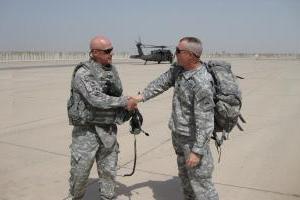 |
|---|
| 1st Squadron, 9th Cavalry Completes TOA |
|---|
|  |
|---|
 Also on 28 May, 1st Squadron, 9th Cavalry Regiment, 4th Brigade Combat Team,
1st Cavalry Division completed the Transfer Of Authority of Forward Operating
Base Hunter to the Soldiers of the 2nd Squadron, 13th Cavalry Regiment, 4th
Brigade Combat Team, 1st Armored Division who will assume the task of securing
the southeastern border of Iraq. A flag changing ceremony symbolically marked
the beginning of Task Force Saber's responsibility for the area.
Also on 28 May, 1st Squadron, 9th Cavalry Regiment, 4th Brigade Combat Team,
1st Cavalry Division completed the Transfer Of Authority of Forward Operating
Base Hunter to the Soldiers of the 2nd Squadron, 13th Cavalry Regiment, 4th
Brigade Combat Team, 1st Armored Division who will assume the task of securing
the southeastern border of Iraq. A flag changing ceremony symbolically marked
the beginning of Task Force Saber's responsibility for the area.
 The TOA process included transferring property, familiarizing themselves with
the area and conducting key leader engagements with prominent local Iraqis.
The squadron recognizes FOB Hunter as their home for the next year and as such
the Soldiers have made strides to improve the living standards. Under the new
command, further improvements are scheduled in order to increase Soldiers'
morale and welfare to include the construction of a new dining facility,
replacement of aging air conditioning systems and the establishment of
reliable personal wireless internet. Despite the excitement of their imminent
return home to Ft. Hood, the outgoing Soldiers made every effort to facilitate
the reception of 2nd Squadron, 13th Cavalry Regiment "Sabers" to FOB
Hunter.
The TOA process included transferring property, familiarizing themselves with
the area and conducting key leader engagements with prominent local Iraqis.
The squadron recognizes FOB Hunter as their home for the next year and as such
the Soldiers have made strides to improve the living standards. Under the new
command, further improvements are scheduled in order to increase Soldiers'
morale and welfare to include the construction of a new dining facility,
replacement of aging air conditioning systems and the establishment of
reliable personal wireless internet. Despite the excitement of their imminent
return home to Ft. Hood, the outgoing Soldiers made every effort to facilitate
the reception of 2nd Squadron, 13th Cavalry Regiment "Sabers" to FOB
Hunter.
 The completion of this transfer sets the foundation for a year-long Saber
deployment to continue efforts in advising and supporting the Iraqi security
forces and the Government of Iraq.
The completion of this transfer sets the foundation for a year-long Saber
deployment to continue efforts in advising and supporting the Iraqi security
forces and the Government of Iraq.
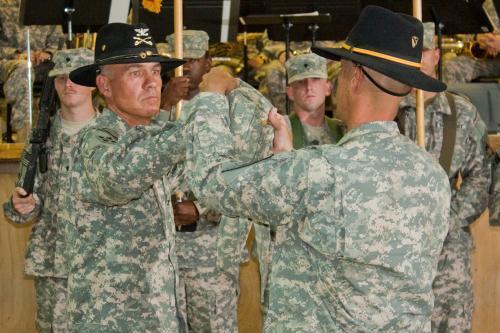 |
|---|
| "Long Knives" Complete Iraq Tour |
|---|
|  |
|---|
 On 05 June, the 4th Brigade Combat Team, 1st Cavalry Division, cased its
colors in a Relief In Place/Transfer Of Authority ceremony at COB Addler, Iraq
that transferred responsibility for coalition operations in southern Iraq to
the 4th Brigade Combat Team, 1st Armored Division.
On 05 June, the 4th Brigade Combat Team, 1st Cavalry Division, cased its
colors in a Relief In Place/Transfer Of Authority ceremony at COB Addler, Iraq
that transferred responsibility for coalition operations in southern Iraq to
the 4th Brigade Combat Team, 1st Armored Division.
 Soldiers assigned to the 4th BCT "Highlanders", 1st Armored Division from
Ft. Bliss, TX unfurled their colors in the Memorial Hall, sending the last of
the Long Knife Soldiers home and ending their year-long tour in the southern
tri-province area of Maysan, Dhi Qar and Muthanna, Iraq.
Soldiers assigned to the 4th BCT "Highlanders", 1st Armored Division from
Ft. Bliss, TX unfurled their colors in the Memorial Hall, sending the last of
the Long Knife Soldiers home and ending their year-long tour in the southern
tri-province area of Maysan, Dhi Qar and Muthanna, Iraq.
 The Long Knife Brigade has laid a firm foundation of security and opportunity
for the people of southern Iraq. The sacrifices of the troopers and their
families gave this part of Iraq an unprecedented atmosphere of hope, success
and optimism. During the yearlong deployment, the Long Knives trained the
Iraqi police, army and border patrols to facilitate those units to assume sole
responsibility for the security of the people in Muthanna, Dhi Qar and Maysan
provinces.
The Long Knife Brigade has laid a firm foundation of security and opportunity
for the people of southern Iraq. The sacrifices of the troopers and their
families gave this part of Iraq an unprecedented atmosphere of hope, success
and optimism. During the yearlong deployment, the Long Knives trained the
Iraqi police, army and border patrols to facilitate those units to assume sole
responsibility for the security of the people in Muthanna, Dhi Qar and Maysan
provinces.
 The brigade also enabled the Provincial Reconstruction Teams in each province
to improve the government and economic development throughout southern Iraq.
After block leave, the Brigade will uncase its colors 23 July at Cooper Field
to mark its official return to Ft. Hood, TX.
The brigade also enabled the Provincial Reconstruction Teams in each province
to improve the government and economic development throughout southern Iraq.
After block leave, the Brigade will uncase its colors 23 July at Cooper Field
to mark its official return to Ft. Hood, TX.

 On 04 May 2009, the "Torch Party" of the 4th Brigade Combat Team, 1st Cavalry
Division composed of 5th Battalion, 82nd Field Artillery Troopers, returned
from Iraq to hundreds of cheering family members, fellow Soldiers and other
guests at a welcoming home ceremony in front of the Division headquarters.
On 04 May 2009, the "Torch Party" of the 4th Brigade Combat Team, 1st Cavalry
Division composed of 5th Battalion, 82nd Field Artillery Troopers, returned
from Iraq to hundreds of cheering family members, fellow Soldiers and other
guests at a welcoming home ceremony in front of the Division headquarters.
 The torch party is sent back earlier than the rest of the unit to help set up
operations for their unit when it starts to deploy in its entirety. Flights
for the 4th BCT Soldiers are scheduled to go on for the next several weeks,
bringing the rest of the brigade back to Ft. Hood, TX.
The torch party is sent back earlier than the rest of the unit to help set up
operations for their unit when it starts to deploy in its entirety. Flights
for the 4th BCT Soldiers are scheduled to go on for the next several weeks,
bringing the rest of the brigade back to Ft. Hood, TX.
 On 10 May, 2009 the second group of more than 300 Soldiers of the 1st Cavalry
Division's 4th Brigade Combat Team came home to Ft. Hood after spending 15
months being deployed in Iraq. Arriving on Mother's Day, they gave out flowers
to their mothers, wives, grandmothers and other special women in their
lives.
On 10 May, 2009 the second group of more than 300 Soldiers of the 1st Cavalry
Division's 4th Brigade Combat Team came home to Ft. Hood after spending 15
months being deployed in Iraq. Arriving on Mother's Day, they gave out flowers
to their mothers, wives, grandmothers and other special women in their
lives.
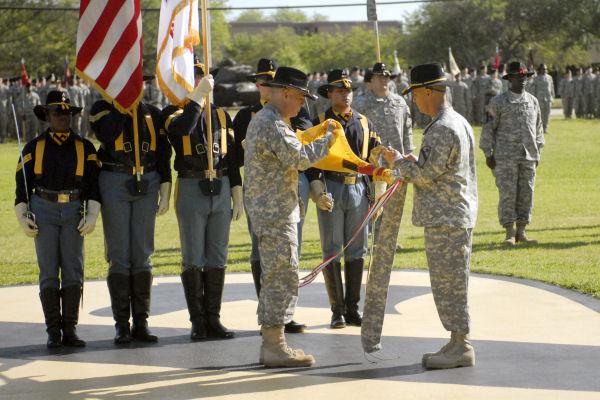 |
|---|
| "Longknives" Uncase Brigade's Colors |
|---|
| |
|---|
 The Long Knife Brigade had returned to Ft. Hood, TX in June after serving a
year long deployment in the tri-province region of southern Iraq. The six
battalions of the Brigade uncased their unit colors during the ceremony to
signify their return to garrison operations.
The Long Knife Brigade had returned to Ft. Hood, TX in June after serving a
year long deployment in the tri-province region of southern Iraq. The six
battalions of the Brigade uncased their unit colors during the ceremony to
signify their return to garrison operations.
 On 08 October, a Defense Department news release announced that the 3rd
Armored Cavalry Regiment and the 4th Brigade Combat Team, 1st Cavalry Division
are among units that will deploy to Iraq next summer as part of annual troop
rotations there. The deploying units will serve 12-month tours. In addition,
the deployment of the 1st Cavalry Division Headquarters will be extended for
up to an additional 23 days, and elements of the II Marine Expeditionary Force
will be extended for up to an additional 79 days.
On 08 October, a Defense Department news release announced that the 3rd
Armored Cavalry Regiment and the 4th Brigade Combat Team, 1st Cavalry Division
are among units that will deploy to Iraq next summer as part of annual troop
rotations there. The deploying units will serve 12-month tours. In addition,
the deployment of the 1st Cavalry Division Headquarters will be extended for
up to an additional 23 days, and elements of the II Marine Expeditionary Force
will be extended for up to an additional 79 days.
 The extensions will ensure that key capabilities are maintained following
Iraqi national elections in January and provide support for redeployment of
remaining Marines and their equipment. The number of troops involved in the
movement will total about 15,000 servicemembers. The units will replace
redeploying units, with no increase in overall force levels.
The extensions will ensure that key capabilities are maintained following
Iraqi national elections in January and provide support for redeployment of
remaining Marines and their equipment. The number of troops involved in the
movement will total about 15,000 servicemembers. The units will replace
redeploying units, with no increase in overall force levels.
 0n 18 November, the 4th Brigade Combat Team, 1st Cavalry Division "Long
Knives" received word of a future deployment to Iraq less than a month ago,
but the Brigade has been focused on preparing for such news since returning
from Iraq in the summer of 2010. A revised training plan has been issued that
nvolves both individual and collective training at Fort Hood, and next May at
the Joint Readiness Training Center at Fort Polk, LA. But before soldiers are
able to train, the unit must receive new equipment, and return old equipment
that is either obsolete or no longer serviceable during a process the Army
refers to as "reset."
0n 18 November, the 4th Brigade Combat Team, 1st Cavalry Division "Long
Knives" received word of a future deployment to Iraq less than a month ago,
but the Brigade has been focused on preparing for such news since returning
from Iraq in the summer of 2010. A revised training plan has been issued that
nvolves both individual and collective training at Fort Hood, and next May at
the Joint Readiness Training Center at Fort Polk, LA. But before soldiers are
able to train, the unit must receive new equipment, and return old equipment
that is either obsolete or no longer serviceable during a process the Army
refers to as "reset."
 Their inventory will be expanded to include new items they didn't have before
from the last time deployed along with modernized items. The upcoming
deployment will be much enhanced by the latest equipment upgrades. The re-set
process not only provides the Long Knife Brigade with the latest equipment
upgrades, but also saves the Army time by cutting out the middle function of
supply services. These inventories will be used for training and for
deployment, and the support here from the 4th Brigade has been excellent.
Their inventory will be expanded to include new items they didn't have before
from the last time deployed along with modernized items. The upcoming
deployment will be much enhanced by the latest equipment upgrades. The re-set
process not only provides the Long Knife Brigade with the latest equipment
upgrades, but also saves the Army time by cutting out the middle function of
supply services. These inventories will be used for training and for
deployment, and the support here from the 4th Brigade has been excellent.
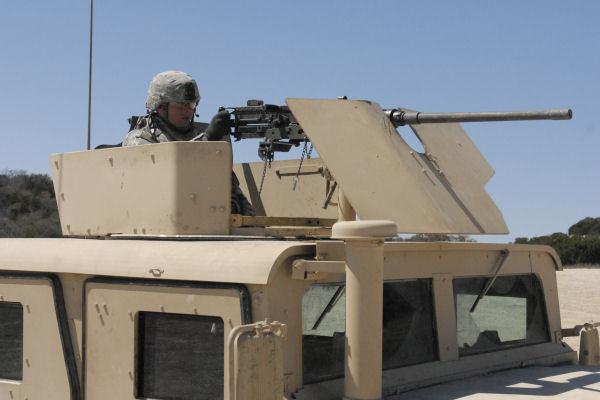 |
|---|
| 4th Brigade Units Initiates Training |
|---|
| |
|---|
 On 12 March 2010, and within weeks of an approaching field training exercise
in preparation for this year's upcoming deployment, troops assigned to the 4th
Brigade Special Troops Battalion, 4th Brigade Combat Team, 1st Cavalry
Division conducted humvee training at the Blackwell Multi-Use Range. The
essential goal for the 4th BSTB field training exercise was the familiariation
and qualification of each Soldier on the tactical vehicle's weapons systems to
gain confidence in their equipment and enabling them to use overwhelming fire
power to suppress the enemy.
On 12 March 2010, and within weeks of an approaching field training exercise
in preparation for this year's upcoming deployment, troops assigned to the 4th
Brigade Special Troops Battalion, 4th Brigade Combat Team, 1st Cavalry
Division conducted humvee training at the Blackwell Multi-Use Range. The
essential goal for the 4th BSTB field training exercise was the familiariation
and qualification of each Soldier on the tactical vehicle's weapons systems to
gain confidence in their equipment and enabling them to use overwhelming fire
power to suppress the enemy.
 The humvees are equiped with either a M2 .50 caliber machine gun, M240B
machine gun or the M249 Squad Automatic Weapons to engage targets out to 600
meters and complete the mission. Depending on the engagement, troops expended
as many as 800 rounds. Although a number of the Spartan Soldiers have had
previous gunnery training, for some of the Soldiers, this was the first time
they fired a weapon from a vehicle making the training as realistic as
possible with what they might experience in the field.
The humvees are equiped with either a M2 .50 caliber machine gun, M240B
machine gun or the M249 Squad Automatic Weapons to engage targets out to 600
meters and complete the mission. Depending on the engagement, troops expended
as many as 800 rounds. Although a number of the Spartan Soldiers have had
previous gunnery training, for some of the Soldiers, this was the first time
they fired a weapon from a vehicle making the training as realistic as
possible with what they might experience in the field.
 Operation New Dawn, 2010 - 2010
Operation New Dawn, 2010 - 2010


 01 September, 2010 marked the official end to Operation IRAQI FREEDOM and
combat operations by United States forces in Iraq. In The transition to
Operation NEW DAWN, the remaining 50,000 US servicemembers serving in Iraq
will conduct stability operations, focusing on advising, assisting and
training Iraqi Security Forces (ISF). Operation NEW DAWN, a compromise of the
Republican and Democrat Parties to vacate the Iraqi operation by mid 2010,
also represents a shift from a predominantly military US presence to one that
is predominantly civilian, as the Departments of Defense and State work
together with governmental and non-governmental agencies to help build civil
capacity of Iraq.
01 September, 2010 marked the official end to Operation IRAQI FREEDOM and
combat operations by United States forces in Iraq. In The transition to
Operation NEW DAWN, the remaining 50,000 US servicemembers serving in Iraq
will conduct stability operations, focusing on advising, assisting and
training Iraqi Security Forces (ISF). Operation NEW DAWN, a compromise of the
Republican and Democrat Parties to vacate the Iraqi operation by mid 2010,
also represents a shift from a predominantly military US presence to one that
is predominantly civilian, as the Departments of Defense and State work
together with governmental and non-governmental agencies to help build civil
capacity of Iraq.
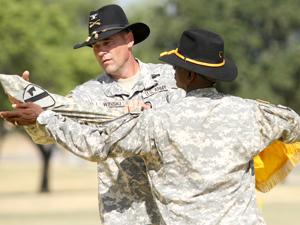 |
|---|
| 4th Combat Brigade Cases Colors |
|---|
| |
|---|
 On 01 September, in a symbolic ceremnony that took place for the 4th Combat
Team of the 1st Calvary Division as they held their colors casing ceremony
at Fort Hood for an historic mission taht will start as they leave this month
in support of Operation NEW DAWN.The 4th Brigade will be the first unit of
the 1st Cavalry Division to leave specifically in support of the new mission.
On 01 September, in a symbolic ceremnony that took place for the 4th Combat
Team of the 1st Calvary Division as they held their colors casing ceremony
at Fort Hood for an historic mission taht will start as they leave this month
in support of Operation NEW DAWN.The 4th Brigade will be the first unit of
the 1st Cavalry Division to leave specifically in support of the new mission.
 The ceremony was filled with the traditions of the 1st Calvary Division,
including soldiers on horses, their historic band, and multiple cannon fire.
At the ceremony, the 4th Brigade introduced the Stability Transition Team. The
new unit is made up of special forces and green berets. As the soldiers of the
4th Brigade marched off the field, the band played the Army song. The 4th
Brigade will once again go marching along, back into Iraq, for what they
believe will be the final time.
The ceremony was filled with the traditions of the 1st Calvary Division,
including soldiers on horses, their historic band, and multiple cannon fire.
At the ceremony, the 4th Brigade introduced the Stability Transition Team. The
new unit is made up of special forces and green berets. As the soldiers of the
4th Brigade marched off the field, the band played the Army song. The 4th
Brigade will once again go marching along, back into Iraq, for what they
believe will be the final time.
 In their new mision, the 4th Brigade will no longer combatants, thry will be
now advising. Leaving to support Operation NEW DAWN, with a plan to come
home with the sun shining brightly on Iraqi freedom. The Long Knife Brigade
will uncase their colors when they get to Iraq, and begin supporting the Iraqi
leadership and forces.
In their new mision, the 4th Brigade will no longer combatants, thry will be
now advising. Leaving to support Operation NEW DAWN, with a plan to come
home with the sun shining brightly on Iraqi freedom. The Long Knife Brigade
will uncase their colors when they get to Iraq, and begin supporting the Iraqi
leadership and forces.
 The unit consisting of 100 soldiers has gone through specialized training to
take charge in making sure over the next year and a half, Iraqi military and
police leaders are prepared to lead the country's security without US back-up
to bail them out.In the meantime, the 4th Brigade will focus on providing
support in Northern Iraq as well, in places like Mosul, Nineveh, Kirkuk, and
along the northern Syrian border.
The unit consisting of 100 soldiers has gone through specialized training to
take charge in making sure over the next year and a half, Iraqi military and
police leaders are prepared to lead the country's security without US back-up
to bail them out.In the meantime, the 4th Brigade will focus on providing
support in Northern Iraq as well, in places like Mosul, Nineveh, Kirkuk, and
along the northern Syrian border.
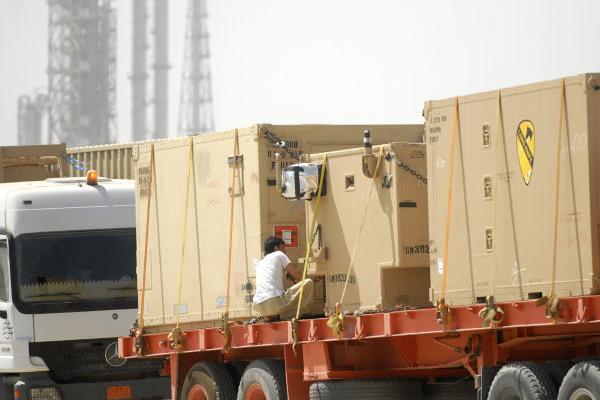 |
|---|
| 4th CBT Port Inspection Operations |
|---|
| |
|---|
 On September 18, with their new mission of Operation NEW DAWN underway,
Soldiers assigned to the 4th Brigade Combat Team, 1st Cavalry Division, have
a few more items to finalize to ensure they are mission ready. Soldiers of the3
2nd Battalion, 12th Cavalry Regiment, staged vehicles, inventoried containers
and prepared for the brigade's equipment movement north from the southern port
at Kuwait City, Kuwait, to Iraq.
On September 18, with their new mission of Operation NEW DAWN underway,
Soldiers assigned to the 4th Brigade Combat Team, 1st Cavalry Division, have
a few more items to finalize to ensure they are mission ready. Soldiers of the3
2nd Battalion, 12th Cavalry Regiment, staged vehicles, inventoried containers
and prepared for the brigade's equipment movement north from the southern port
at Kuwait City, Kuwait, to Iraq.
 With their new advise and assist mission, it is crucial for Soldiers to have
their equipment in Iraq on time. The operation not only oversaw the specializd
weapon platform equipment essential to support the Combat Team, but it also
included supplies critical for maintaining and sustaining the combat
platforms. Soldiers rotated shifts and worked through the night to guarantee
their fellow Soldiers would have mission essential equipment ready for Iraq.
Without the brigade being properly equipped and ready to take on any mission,
it forces units to have to do a lot more with fewer tools, which leads to
individual stress. By being involved in pushing the equipment forward, it
alleviates those worries.
With their new advise and assist mission, it is crucial for Soldiers to have
their equipment in Iraq on time. The operation not only oversaw the specializd
weapon platform equipment essential to support the Combat Team, but it also
included supplies critical for maintaining and sustaining the combat
platforms. Soldiers rotated shifts and worked through the night to guarantee
their fellow Soldiers would have mission essential equipment ready for Iraq.
Without the brigade being properly equipped and ready to take on any mission,
it forces units to have to do a lot more with fewer tools, which leads to
individual stress. By being involved in pushing the equipment forward, it
alleviates those worries.
 With the equipment of the brigade en route to Iraq, troopers now stand one
step closer to beginning their mission of helping the Iraqi nation become
self-reliant and providing for their own security. Brigade port operations is
an important transition that began in 2003, By ensuring that the efforts in
the last seven years finish successfully, defending this nation against
external threats.
With the equipment of the brigade en route to Iraq, troopers now stand one
step closer to beginning their mission of helping the Iraqi nation become
self-reliant and providing for their own security. Brigade port operations is
an important transition that began in 2003, By ensuring that the efforts in
the last seven years finish successfully, defending this nation against
external threats.
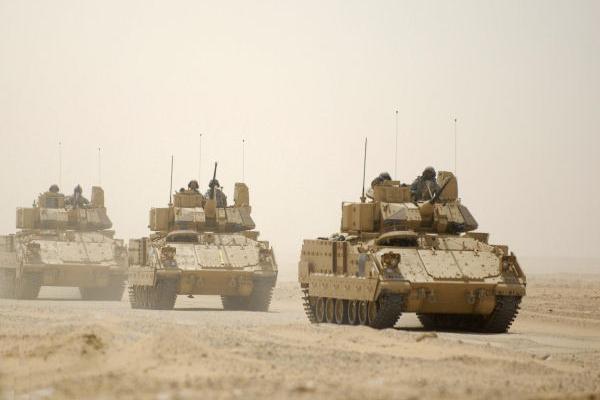 |
|---|
| 4th CBT Prepares to Head North |
|---|
| |
|---|
 Troopers from 4th Brigade Combat Team, 1st Cavalry Division, maintained their
combat readiness with training classes at Camp Buehring, located in the desert
of Kuwait, prior to their deployment north into Iraq in the coming weeks. Long
Knife brigade Soldiers will be the first brigade combat team from the Division
to deploy in support of Operation NEW DAWN
Troopers from 4th Brigade Combat Team, 1st Cavalry Division, maintained their
combat readiness with training classes at Camp Buehring, located in the desert
of Kuwait, prior to their deployment north into Iraq in the coming weeks. Long
Knife brigade Soldiers will be the first brigade combat team from the Division
to deploy in support of Operation NEW DAWN
 A unit consisting of 100 soldiers has gone through specialized training to
take charge in making sure over the next year and a half, Iraqi military and
police leaders are prepared to lead the country's security without US back-up
to bail them out.In the meantime, the 4th Brigade will focus on providing
support in Northern Iraq as well, in places like Mosul, Nineveh, Kirkuk, and
along the northern Syrian border.
A unit consisting of 100 soldiers has gone through specialized training to
take charge in making sure over the next year and a half, Iraqi military and
police leaders are prepared to lead the country's security without US back-up
to bail them out.In the meantime, the 4th Brigade will focus on providing
support in Northern Iraq as well, in places like Mosul, Nineveh, Kirkuk, and
along the northern Syrian border.
 On September 20, soldiers assigned to 1st Squadron, 9th Cavalry Regiment, 4th
Brigade, 1st Cavalry Division, conducted final checks of their Bradley
fighting vehicles weapon systems, prior to moving into Iraq later this month.
In crews of three; consisting of a driver, a gunner, and a Bradley commander,
troopers drove for over two hours to get to the range where their training
would begin.
On September 20, soldiers assigned to 1st Squadron, 9th Cavalry Regiment, 4th
Brigade, 1st Cavalry Division, conducted final checks of their Bradley
fighting vehicles weapon systems, prior to moving into Iraq later this month.
In crews of three; consisting of a driver, a gunner, and a Bradley commander,
troopers drove for over two hours to get to the range where their training
would begin.
 The unit consisting of 100 soldiers has gone through specialized training to
take charge in making sure over the next year and a half, Iraqi military and
police leaders are prepared to lead the country's security without US back-up
to bail them out.In the meantime, the 4th Brigade will focus on providing
support in Northern Iraq as well, in places like Mosul, Nineveh, Kirkuk, and
along the northern Syrian border.
The unit consisting of 100 soldiers has gone through specialized training to
take charge in making sure over the next year and a half, Iraqi military and
police leaders are prepared to lead the country's security without US back-up
to bail them out.In the meantime, the 4th Brigade will focus on providing
support in Northern Iraq as well, in places like Mosul, Nineveh, Kirkuk, and
along the northern Syrian border.
 Soldiers positively indentified exactly what types of targets were down range
and used the on-board computer to aim and engage them with the appropriate
type of weapon system. While much of the work reconfirmed training that the
Head Hunters conducted prior to their deployment, troopers worked on their
communication skills to ensure they will be ready to assist their Iraqi
counterparts if needed during their deployment in support of Operation NEW
DAWN.
Soldiers positively indentified exactly what types of targets were down range
and used the on-board computer to aim and engage them with the appropriate
type of weapon system. While much of the work reconfirmed training that the
Head Hunters conducted prior to their deployment, troopers worked on their
communication skills to ensure they will be ready to assist their Iraqi
counterparts if needed during their deployment in support of Operation NEW
DAWN.
 The training that started in the daylight soon proceeded into the night hours,
but through communication and confirmed shots, Soldiers ended the day with
more knowledge of and confidence in their weapons systems.
The training that started in the daylight soon proceeded into the night hours,
but through communication and confirmed shots, Soldiers ended the day with
more knowledge of and confidence in their weapons systems.
 The Soldiers participated in weapon certification ranges, combat life-saving
classes, humvee egress assistance training and counter improvised explosive
device classes to refresh the skills they acquired during brigade field
training exercises and at the Joint Readiness Training Center (JRTC) in Fort
Polk, LA.
The Soldiers participated in weapon certification ranges, combat life-saving
classes, humvee egress assistance training and counter improvised explosive
device classes to refresh the skills they acquired during brigade field
training exercises and at the Joint Readiness Training Center (JRTC) in Fort
Polk, LA.
 The Soldiers will continue their refresher classes and training prior to
their movement to northern Iraq for their scheduled deployment.
The Soldiers will continue their refresher classes and training prior to
their movement to northern Iraq for their scheduled deployment.
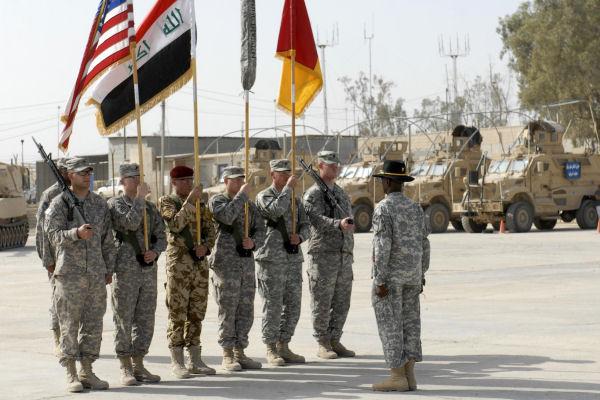 |
|---|
| 4th Combat Brigade Uncases Colors |
|---|
| |
|---|
 18 Oct 2010. after being in Iraq for nearly a month, the 4th Advise and
Assist Brigade, 1st Cavalry Division, officially uncased its colors and took
part in a colorful transfer of authority ceremony to assume authority in
Ninewa Provinceal Contingency Operating Site at Marez, Iraq.
18 Oct 2010. after being in Iraq for nearly a month, the 4th Advise and
Assist Brigade, 1st Cavalry Division, officially uncased its colors and took
part in a colorful transfer of authority ceremony to assume authority in
Ninewa Provinceal Contingency Operating Site at Marez, Iraq.
 The ceremony officially recognizes the Long Knife brigade assuming authority
for advising, assisting, and training Iraqi counterparts in Ninewa Province
and Mosul, in northern Iraq.
The ceremony officially recognizes the Long Knife brigade assuming authority
for advising, assisting, and training Iraqi counterparts in Ninewa Province
and Mosul, in northern Iraq.
 Accepting responsibility for the mission from the 2nd Advise and Assist
Brigade, 3rd Infantry Division, Long Knife Soldiers will now be working
directly with their Iraqi counterparts in support of Operation NEW DAWN.
Accepting responsibility for the mission from the 2nd Advise and Assist
Brigade, 3rd Infantry Division, Long Knife Soldiers will now be working
directly with their Iraqi counterparts in support of Operation NEW DAWN.
 The transfer of authority (TOA) gives the 4th Brigade a chance to thank the
Spartan brigade for the hard work done over the last year and a chance for
them to show our Iraqi counterparts here to continue to assist them with
their security training. In their role as an AAB, Soldiers of the 4th AAB
will conduct combined patrols, assist at checkpoints and train the ISF, who
are in the lead for all operations.
The transfer of authority (TOA) gives the 4th Brigade a chance to thank the
Spartan brigade for the hard work done over the last year and a chance for
them to show our Iraqi counterparts here to continue to assist them with
their security training. In their role as an AAB, Soldiers of the 4th AAB
will conduct combined patrols, assist at checkpoints and train the ISF, who
are in the lead for all operations.
 The focus of the effort of the 4th Brigade is to advise, train, and assist
Iraqi Security Forces marking what will amount to be the cloase out of efforts
over the last seven years. Each commander spoke during the ceremony with the
commander of the redeploying Spartan brigade, Col. Charles Sexton, welcoming
the Long Knife brigade and wishing them luck on their journey to helping Iraq
achieve independence.
The focus of the effort of the 4th Brigade is to advise, train, and assist
Iraqi Security Forces marking what will amount to be the cloase out of efforts
over the last seven years. Each commander spoke during the ceremony with the
commander of the redeploying Spartan brigade, Col. Charles Sexton, welcoming
the Long Knife brigade and wishing them luck on their journey to helping Iraq
achieve independence.
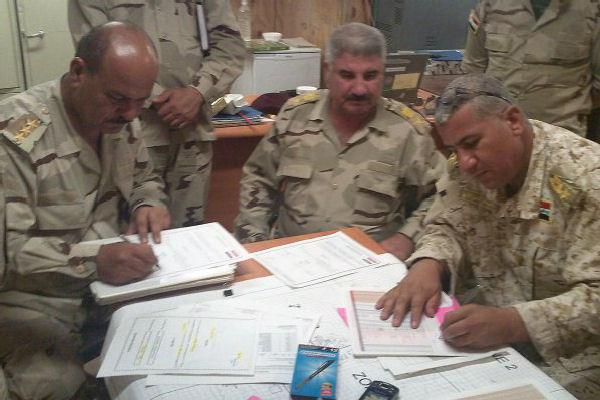 |
|---|
| US Transfers Responsibility For COS Sykes |
|---|
| |
|---|
 Also on 14 June, US forces officially transferred responsibility of
Contingency Operating Site (COS) Sykes to Iraqi Security Forces, Soldiers
assigned to "A" Battery, 5th Battalion, 82nd Field Artillery Regiment, 4th
Advise and Assist Brigade, spent more than a month preparing the base for
turnover to the 10th Brigade, 3rd Iraqi Army Division.
Also on 14 June, US forces officially transferred responsibility of
Contingency Operating Site (COS) Sykes to Iraqi Security Forces, Soldiers
assigned to "A" Battery, 5th Battalion, 82nd Field Artillery Regiment, 4th
Advise and Assist Brigade, spent more than a month preparing the base for
turnover to the 10th Brigade, 3rd Iraqi Army Division.

Needs Data
 The "Long Knife" Brigade Combat Team stands ready to lead the way to any
contingency area world-wide to accomplish any mission that the future might
bring.
The "Long Knife" Brigade Combat Team stands ready to lead the way to any
contingency area world-wide to accomplish any mission that the future might
bring.


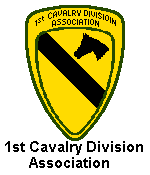












 eMail Your WebSite Comments.
eMail Your WebSite Comments.


 Return to "MyOwnPages"©.
Return to "MyOwnPages"©.

Copyright © 1996, Cavalry Outpost Publications ® and
Trooper Wm. H. Boudreau, "F" Troop, 8th Cavalry Regiment (1946 - 1947). All
rights to this body of work are reserved and are not in the public domain, or
as noted in the bibliography. Reproduction, or transfer by electronic means,
of the History of the 1st Cavalry Division, the subordinate units or any
internal element, is not permitted without prior authorization. Readers are
encouraged to link to any of the pages of this Web site, provided that proper
acknowledgment attributing to the source of the data is made. The information
or content of the material contained herein is subject to change without
notice.
Revised 10 Oct '11 SpellChecked



![]()
 Army Modular Force, 2005
Army Modular Force, 2005






